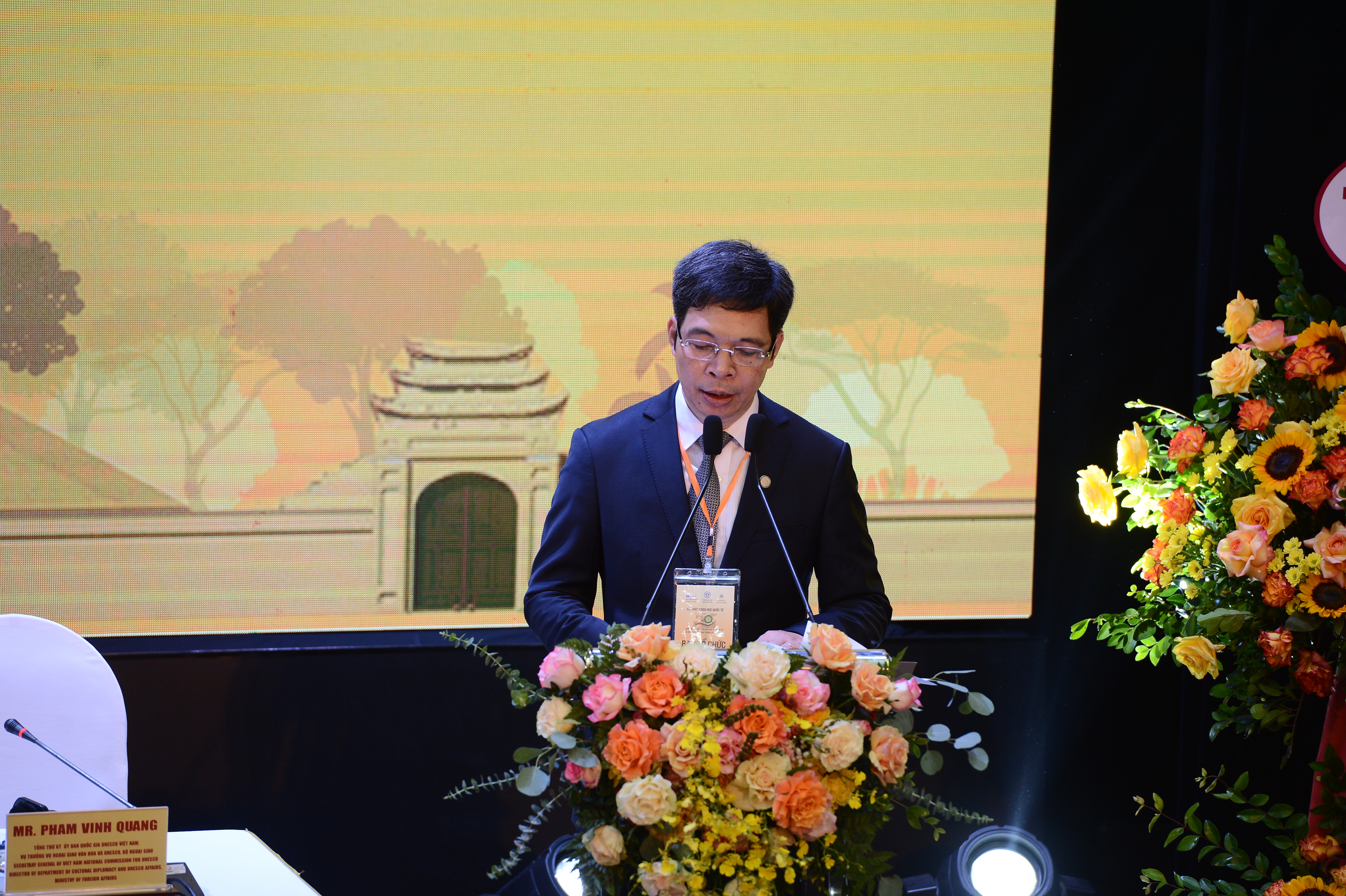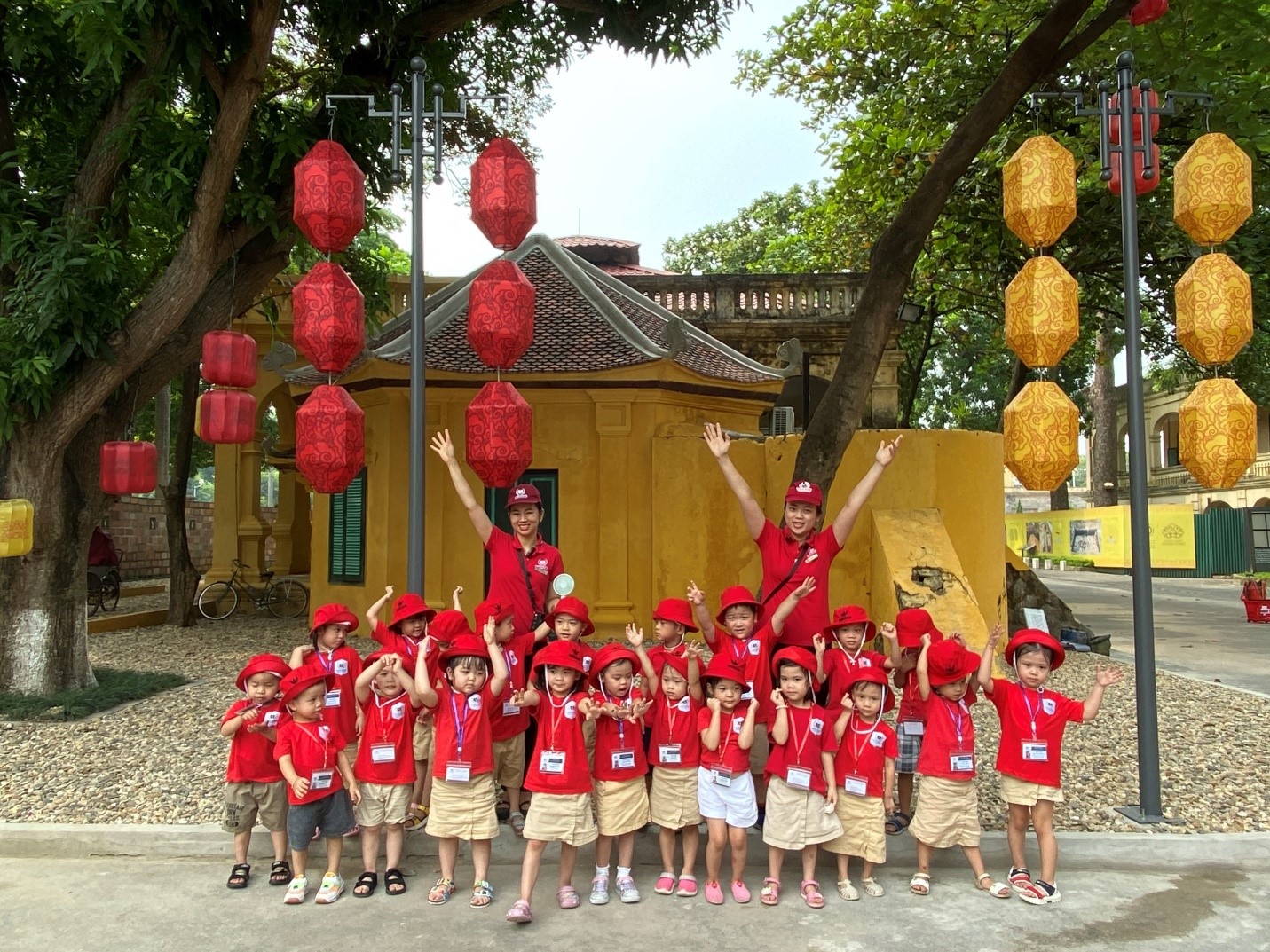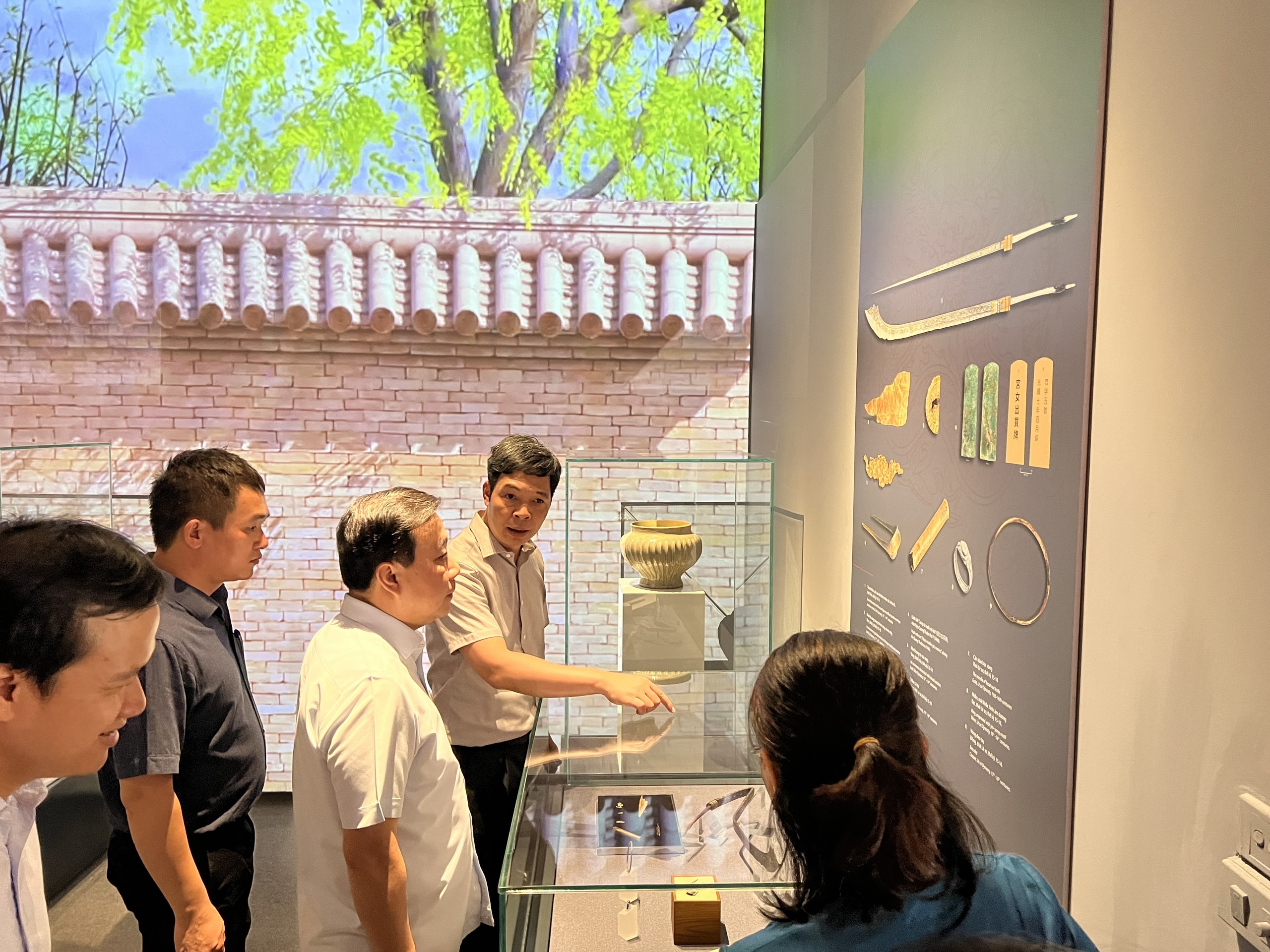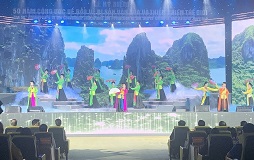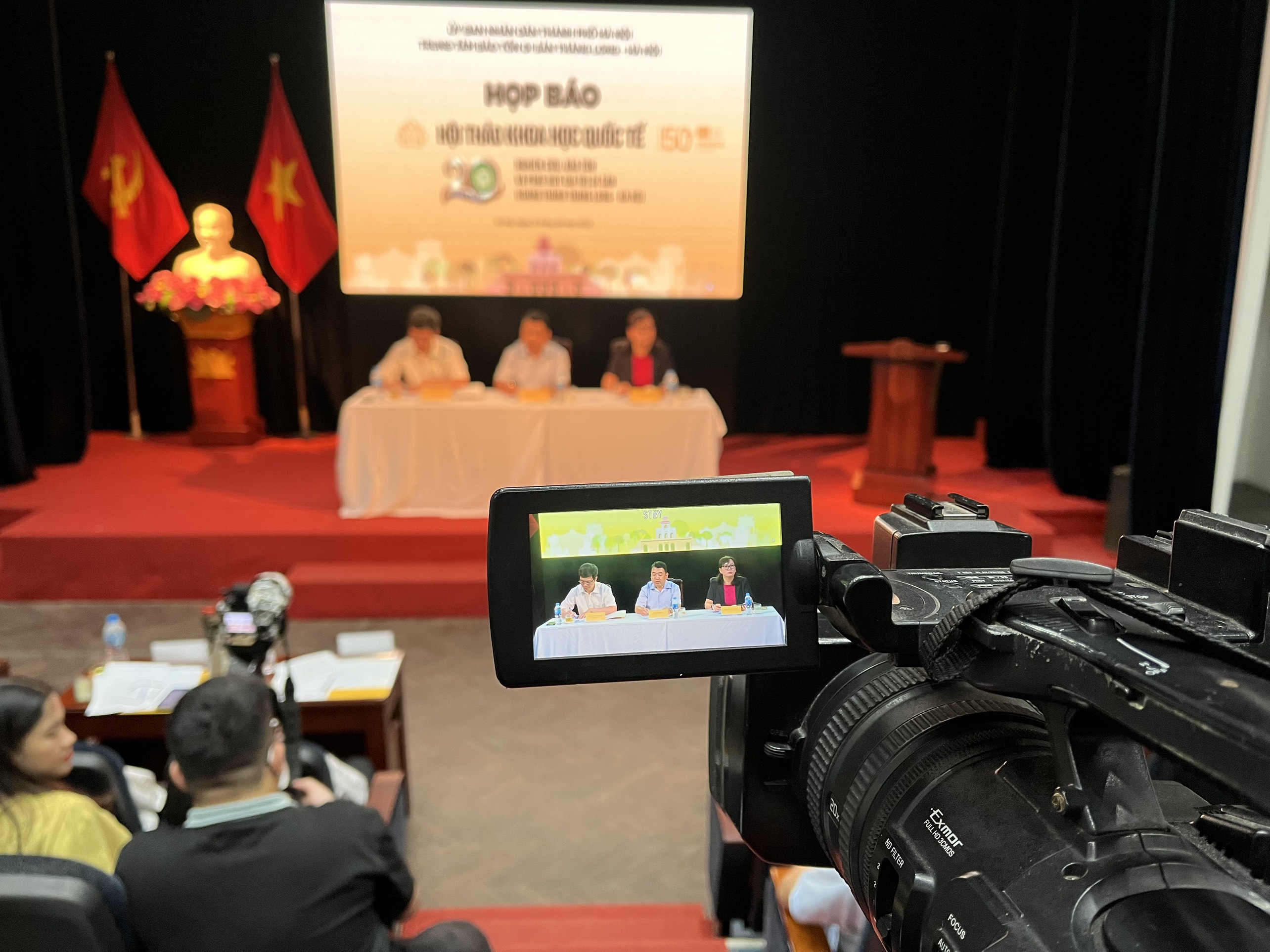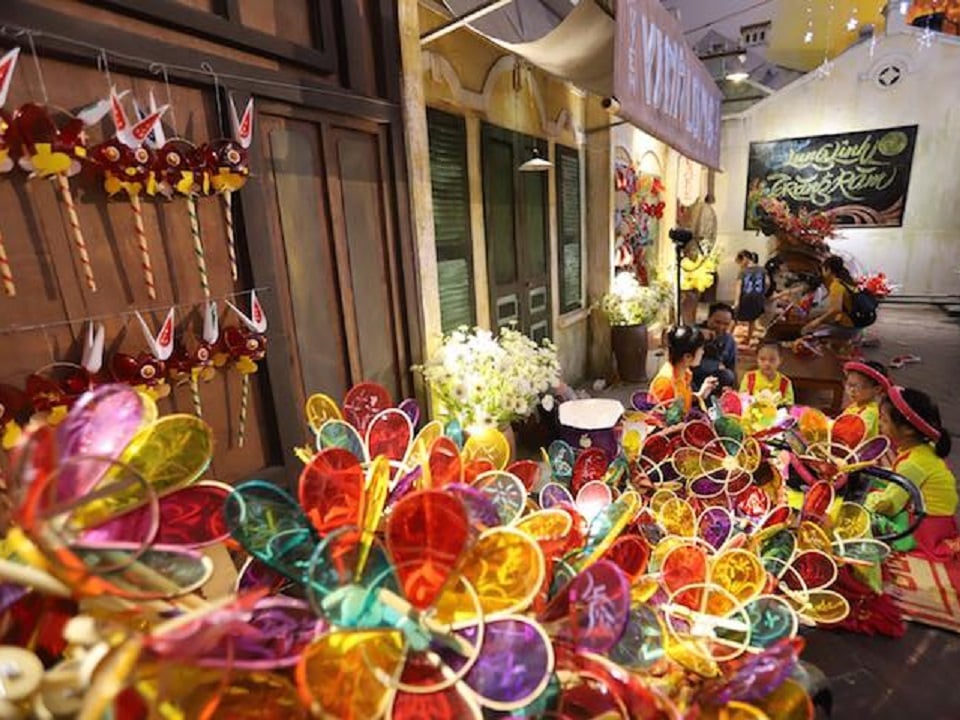The Presidium of the Conference on the morning of September 9, 2022
Assoc. Prof. Dr. Tran Duc Cuong - President of Vietnam Historical Science Association - Vice Chairman of Scientific Advisory Council for Research on Co Loa relic site - Hanoi Citadel;
Ms. Nao Hayashi - Asia-Pacific Culture Specialist, World Heritage Center
Ambassador Le Thi Hong Van - Chief Representative of the Vietnamese Delegation to UNESCO (in Paris, France)
Assoc. Prof. Dr. Dang Van Bai - Vice Chairman of the National Council of Cultural Heritage
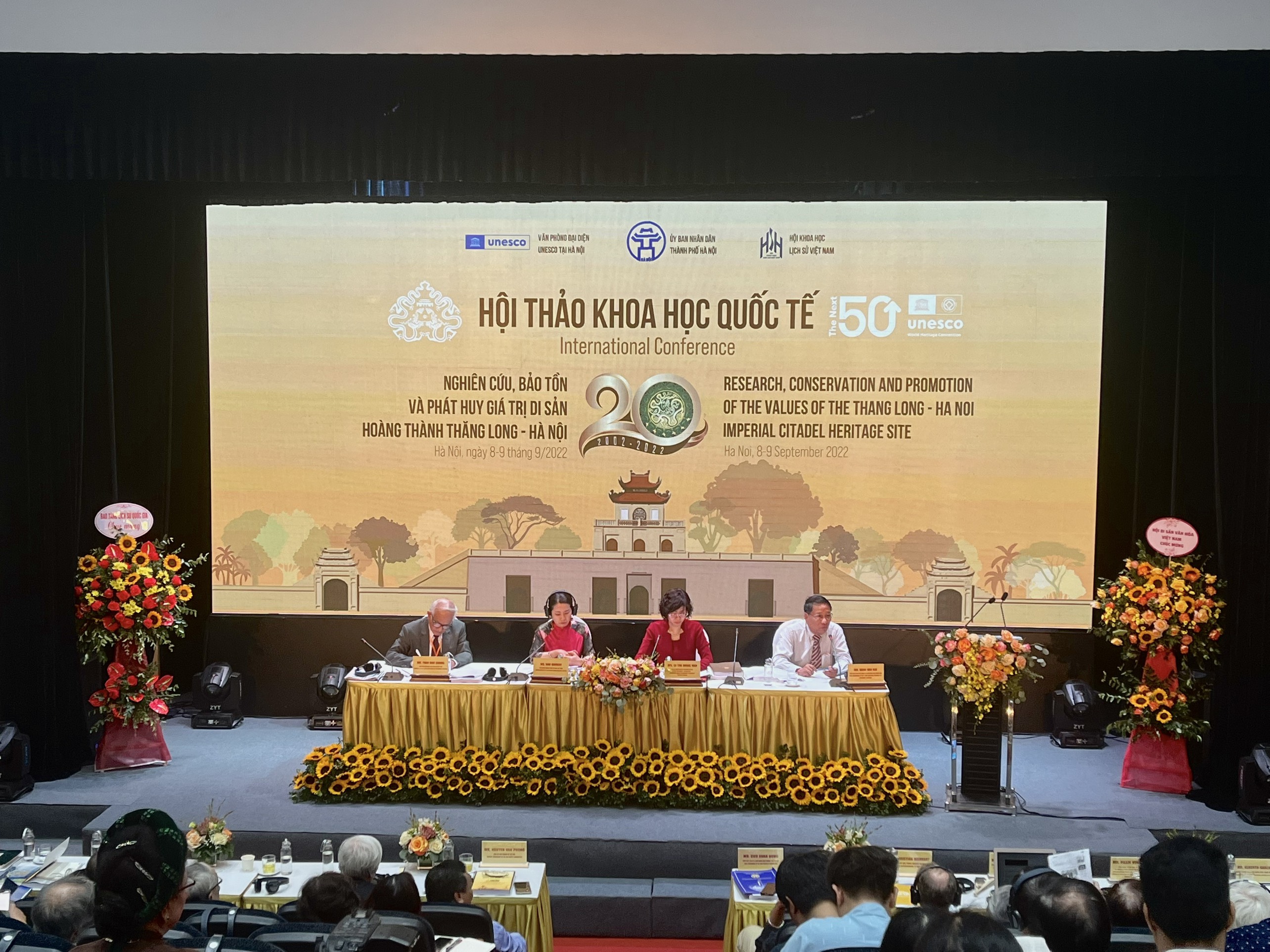
Speech by Mr. Emmanuel CERISE - Director of PRX Vietnam (representative of the Ile de France region) in Hanoi
Suggestions for the model and planning of exhibition space archeology and architecture for Imperial Citadel of Thang Long and Hanoi, opportunities for cooperation between Hanoi and the Ile de france region
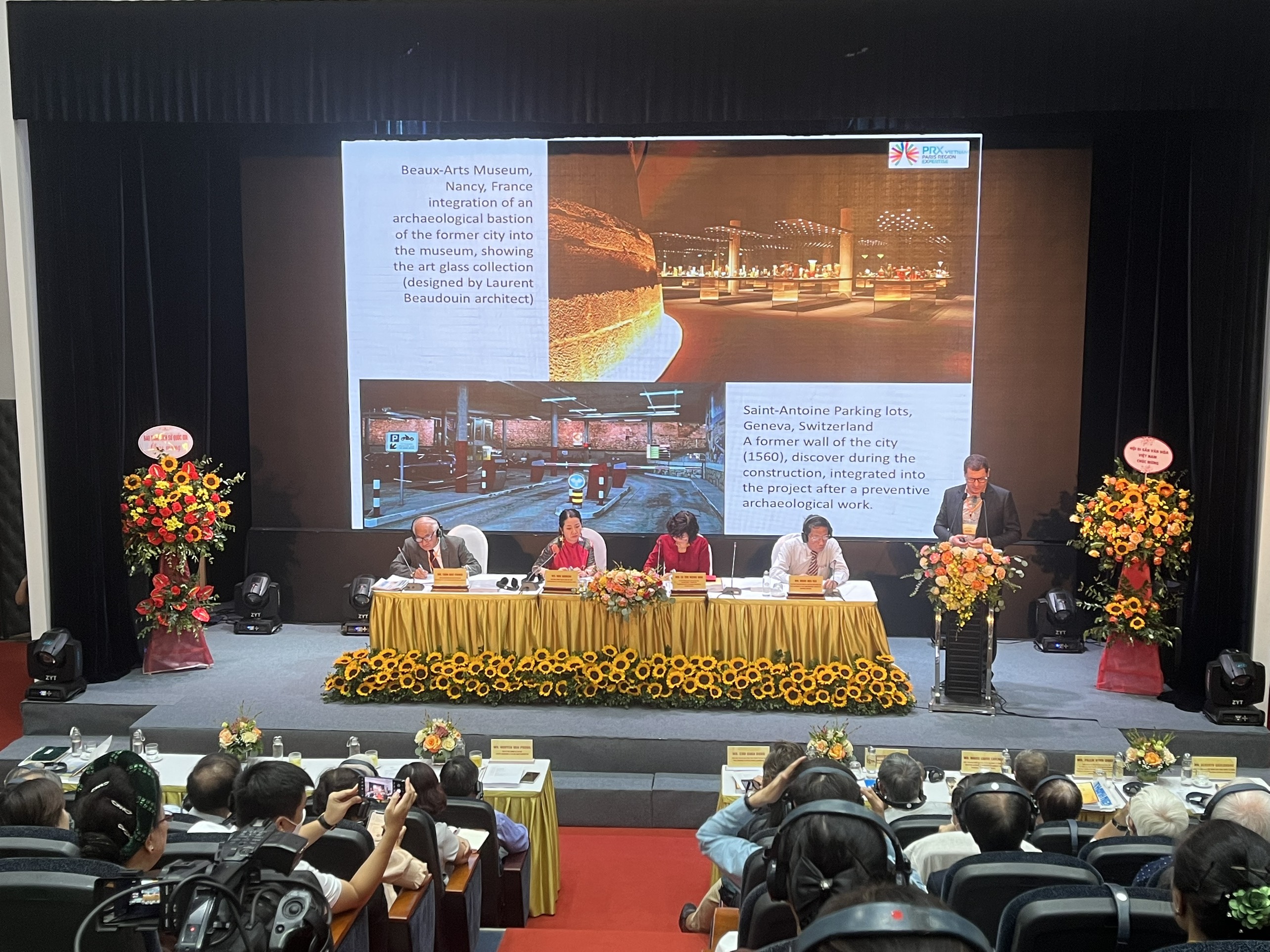
Urban archeology is currently facing many difficulties and obstacles in preserving and promoting its values. Urban heritage is easily destroyed, the conservation and promotion work encounters many obstacles and limitations due to urban development, infrastructure development such as traffic, restaurants, shops, etc. The panel discussion is about archaeological sites as a potential for urban design projects integrated in contemporary urban development. We will present models from the Ile de France Region (IDF) and Europe, and point out some opportunities for cooperation between Hanoi and the Ile de France Region.
1. Models
The Saint - Denis Archaeological Site (Ile de France) is a model of the archaeological site integrated in the urban renovation project, using landscape and urban design to preserve heritage and represent historical vestiges. history in the past.
The Heritage Sites of Saint Laurent and the Pastoral College in Aosta (Italy) are an example of the permanent management of an urban archaeological site for historical, cultural and touristic purposes.
2. Cooperation between Hanoi and Ile de France
Some of the archaeological sites in the Ile de France Region are located in urban areas, for example the city of Lutèce (Roman times) or Cluny (medieval times), some are located in the suburbs or in the countryside. villages such as the Gallo-Roan Heritage Site of the Vaux de la Celle (Genainville).
The Ile de France region, together with PRX-Vietnam, can assist in connecting the historical sites of Hanoi and the heritage sites in the Ile de France region; building cooperation, exchange and technical assistance, such as the cooperation between the medieval town of Provins and the Citadel of Hanoi, the support of the French Ministry of Culture in the field of training and fostering for staff French-speaking working at historic sites.
Collaboration opportunities can be:
- Collaboration on a specific project, for example a project to design a contemporary city to preserve and promote heritage;
- Technical support in the field of communication and promotion;
- Support to build a network of heritage sites (in Hanoi and between the heritage sites of Hanoi and the Ile de France);
- Introduce highly specialized architects, urban designers and landscape designers to work in archaeological and historical sites.
Lecture of GS. Kunikazu Une - Professor Emeritus of Nara Women's University
Experience in restoring architecture from archaeological sites.
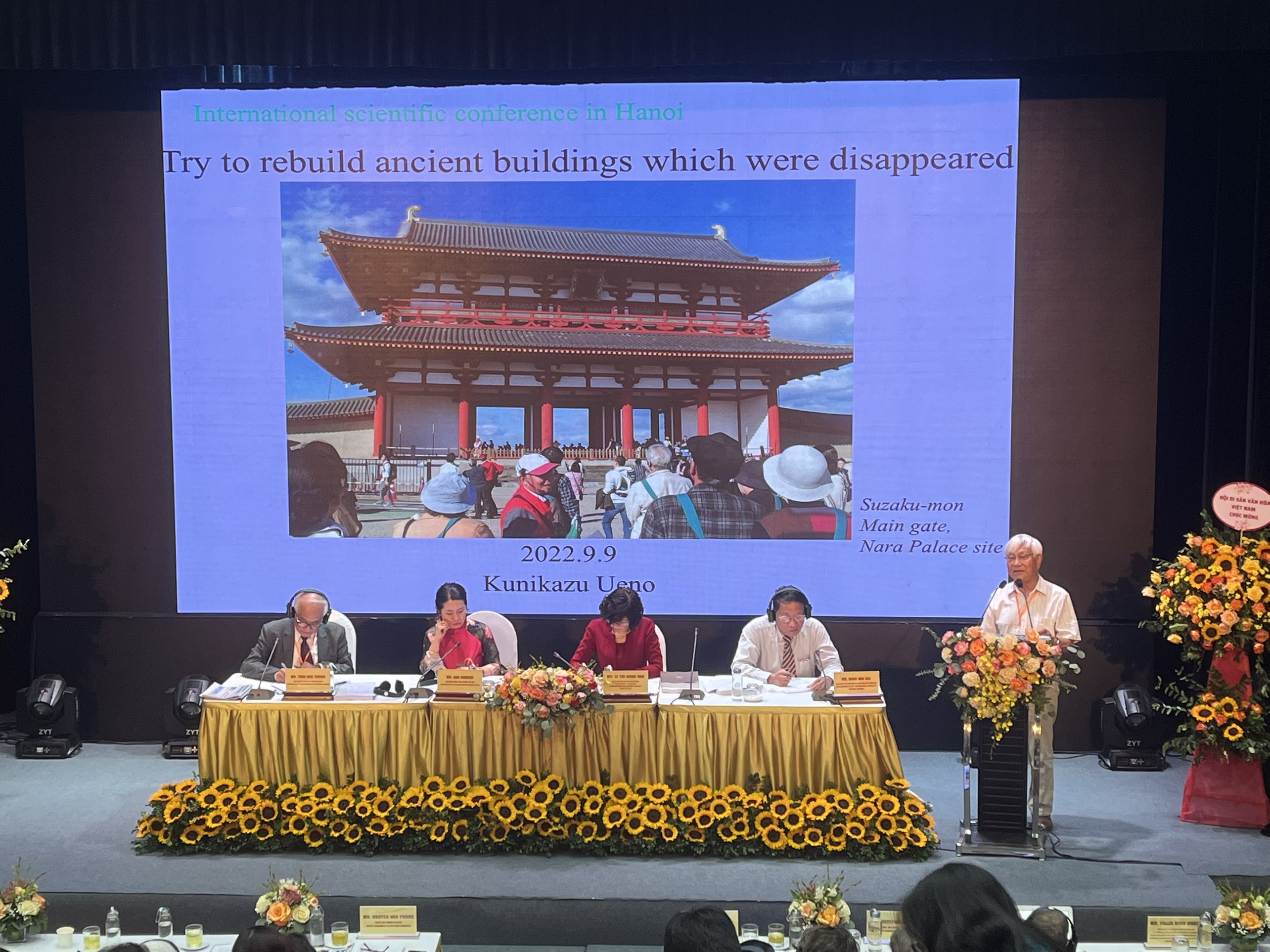
Structures in Japan were built of wood, so they were mostly destroyed over time. Very few ancient structures have survived to this day and all are Buddhist structures. During the excavation process, we have discovered many relics and vestiges of ancient works.
In Japan, we have a lot of experience in rebuilding destroyed buildings with only traces left behind. In my presentation, I will briefly introduce some of the reconstructed structures in Japan such as Suzaku-mon (main gate), Daigoku-den (main hall) and Tou-in (east garden). in “Heijou-kyu”: Nara Palace Site). These buildings were built in the middle of the 8th century. And I also introduce another building built in the middle of the 9th century which is the main south gate at “Shiwa-jo”.
How do we get an idea of what those ancient structures will look like? First, we can rely on the results of archeology. After that, we restored the destroyed structures based on the research results. We can build sketches (I think it's like 70% - 80% of ancient architecture, however we will have the problem that there are some details that can't be determined exactly, sometimes there are ideas. differing opinions on the underlying idea).
Studying the ancient structures that still exist today in Japan, fortunately we still have about 60 ancient structures. This is a resource that provides a lot of information about the age and structure of ancient architecture.
During research, we often have to build models at scale 1/50 to 1/100. We check for various issues during the restoration process. When welcoming the public to visit the reconstruction, we must pay attention to at least two issues: safety and preservation of the original artifacts.
Safety: After the reconstruction is completed, everyone will visit the building. We need to establish safety in reconstructed buildings.
Preservation of archaeological relics: The work is restored on the principle of never destroying artifacts of original value.
Presentation by Assoc. Prof. Dr. Le Thi Thu Hien - Director of Cultural Heritage Department, Ministry of Culture, Sports and Tourism (Presentation: Mr. Tran Dinh Thanh - Deputy Director)
Orientation for management of world cultural heritages Imperial Citadel of Thang Long - Hanoi according to the point of view of sustainable development of Unesco

Vietnam currently has 8 World Cultural and Natural Heritages, of which Imperial City Center Thang Long - Hanoi citadel was recognized by UNESCO in 2010, marking a big step forward in the research process of this particularly important heritage site.
On the basis of 06 contents of World Heritage management identified under the Convention, the Guidelines for the implementation of the 1972 Convention and Vietnam's practice, the discussion clarifies the management status of the Central Citadel of Thang Long. Long - Hanoi after 20 years of research and conservation, through the understanding of the process:
1. Building the management apparatus and human resources of the Imperial Citadel of Thang Long - Hanoi.
2. Formulating and promulgating legal documents on World Heritage management.
3. Develop a plan for management, planning and investment of financial resources.
4. Scientific and technical research activities.
5. International cooperation.
6. World Heritage Monitoring.
At the same time, on the basis of an overall assessment when compared with the management status of other World Cultural and Natural Heritage sites in Vietnam, to propose solutions to improve the efficiency of heritage management, including: The whole solution needs to strengthen the integration of activities to protect and promote the World Heritage values of the Central Imperial Citadel of Thang Long - Hanoi with the sustainable development perspective of UNESCO in the coming time.
Presentation of Ms. Nao Hayashi – Asia-Pacific cultural expert, World Heritage Center
Preserving outstanding global values of World
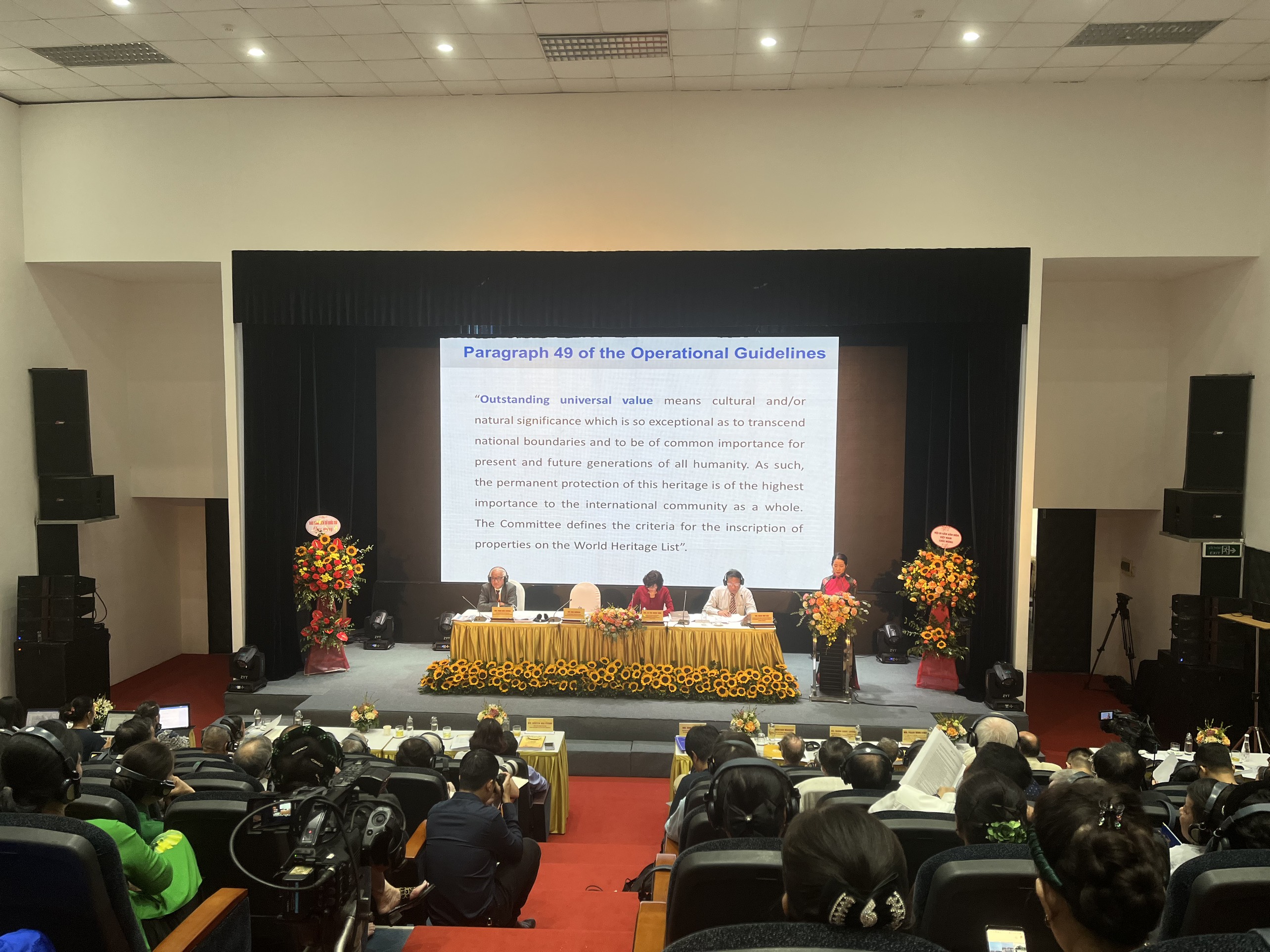
Heritage Sites The World Heritage Convention was established in 1972 by the Countries around the world are increasingly aware that the responsibility for preserving some natural or cultural heritage sites of universal value belongs not only to individual countries but also to the entire international community.
Up to now, 1154 heritages have been inscribed on the World Heritage List. The Convention has a total of 194 member states including 27 countries that have not yet registered any heritage.
A site, once inscribed on the World Heritage List, becomes a member of the global community of this Convention. The World Heritage Convention is one of the most widely followed legal instruments.
In addition to the main text of the Convention, which presents the legal provisions of the World Heritage regime and its most important rules, the operational guidelines (most recently revised for 2021) also provide technical and detailed guidance to assist in the implementation of the convention.
For example, the Guidelines include procedures for developing a tentative list of nominees, a process for preparing nominations, and importantly, guidance on various aspects of the management, conservation, and monitoring of these resources. The property is a World Heritage Site.
In 2022, its 50th anniversary, the Convention is facing many challenges arising from changes in lifestyles, in conceptions of heritage and its significance in the general context of the agenda. Sustainable Development.
Preserving Outstanding Universal Values requires constant reflection, contemplation and innovation to bring harmony between the needs of modern life, heritage values and people's aspirations for a future. better.
Comment of Mr. Jean Francois Milou – French expert, Studio Milou Singapore office
Researching architectural design solutions to preserve and promote the value of archaeological site 18 Hoang Dieu
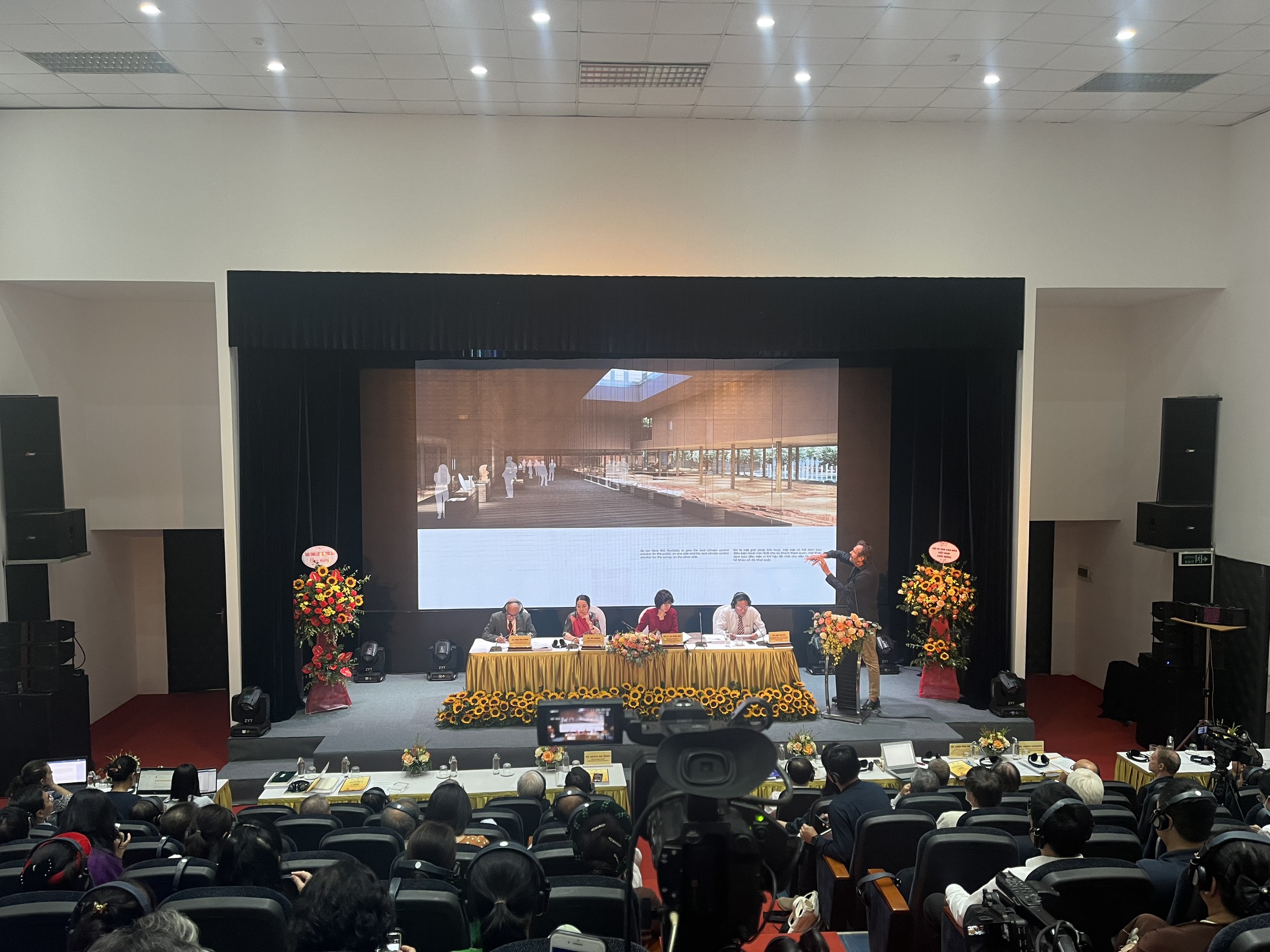
Experts and scientists at home and abroad participated in the discussion of
GSTS Architects Nguyen Quoc Thong's
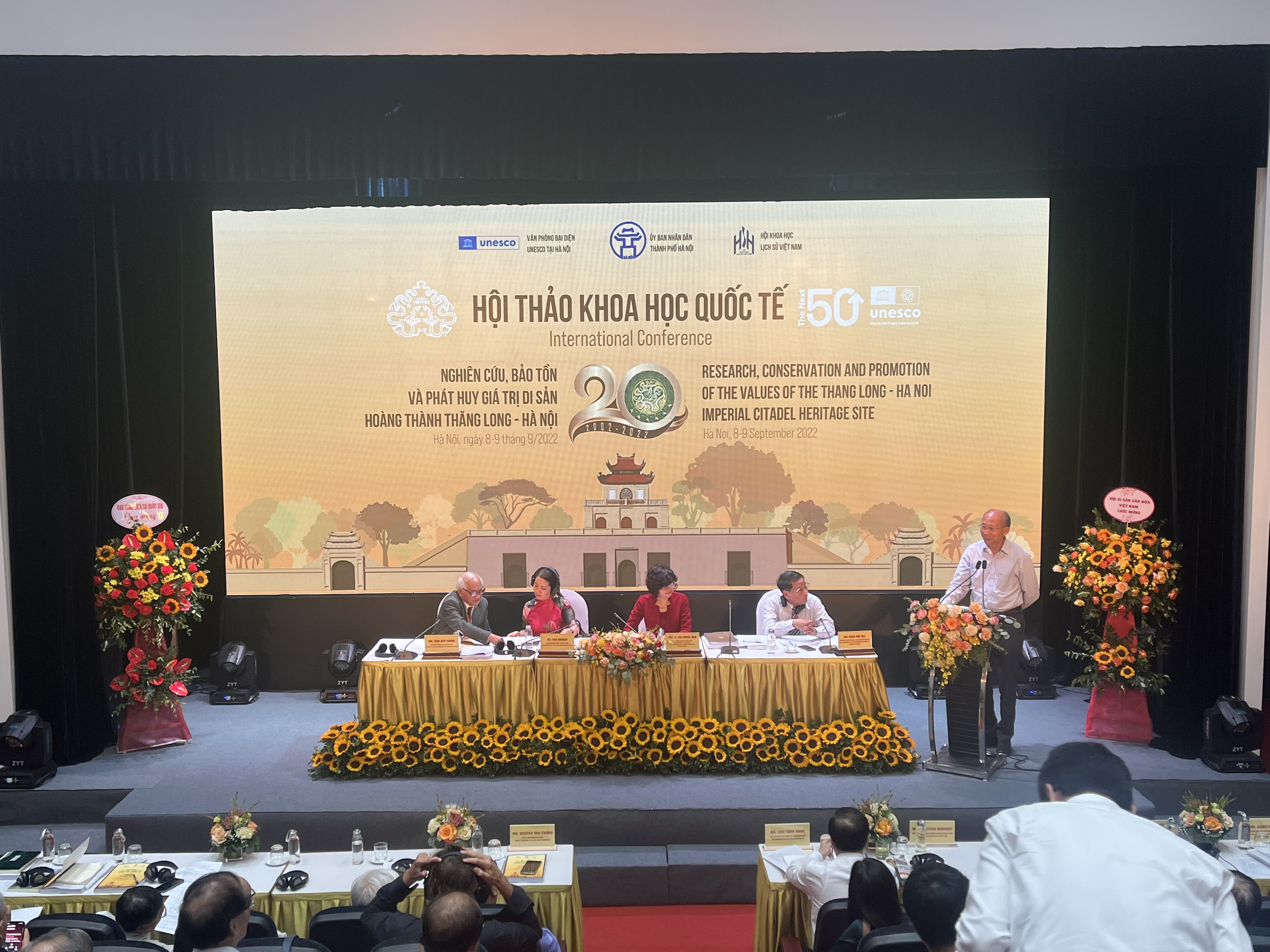
speeches on restoration of electricity and space of Kinh Thien Palace: He thinks this is an opportunity, up to this point it is an opportunity. what we have to do, we have certain scientific bases, the most basic that can be asserted, the structure or position of the highest center of power has been determined.
In the course of further research, a multidisciplinary collaboration is needed, including architects specializing in conservation, heritage, architecture and urbanism.
Mr. Tomoda Masahiko
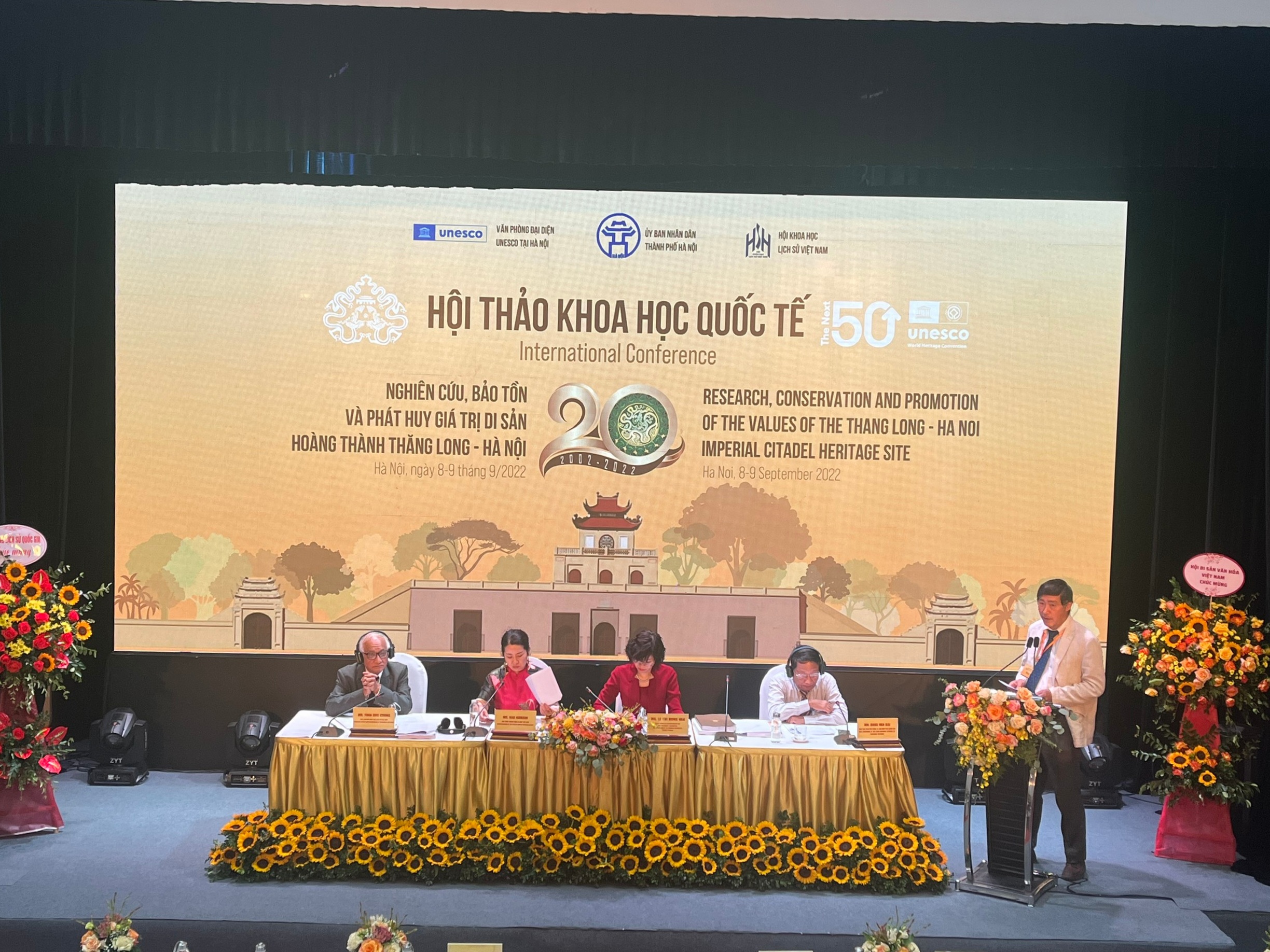
He said that there should be general principles before carrying out conservation and promotion of heritage values.
He emphasized the problem: care should be taken between the display and preservation of discovered archaeological artifacts.
Mr. Truong Minh Tien - President of Hanoi UNESCO Association
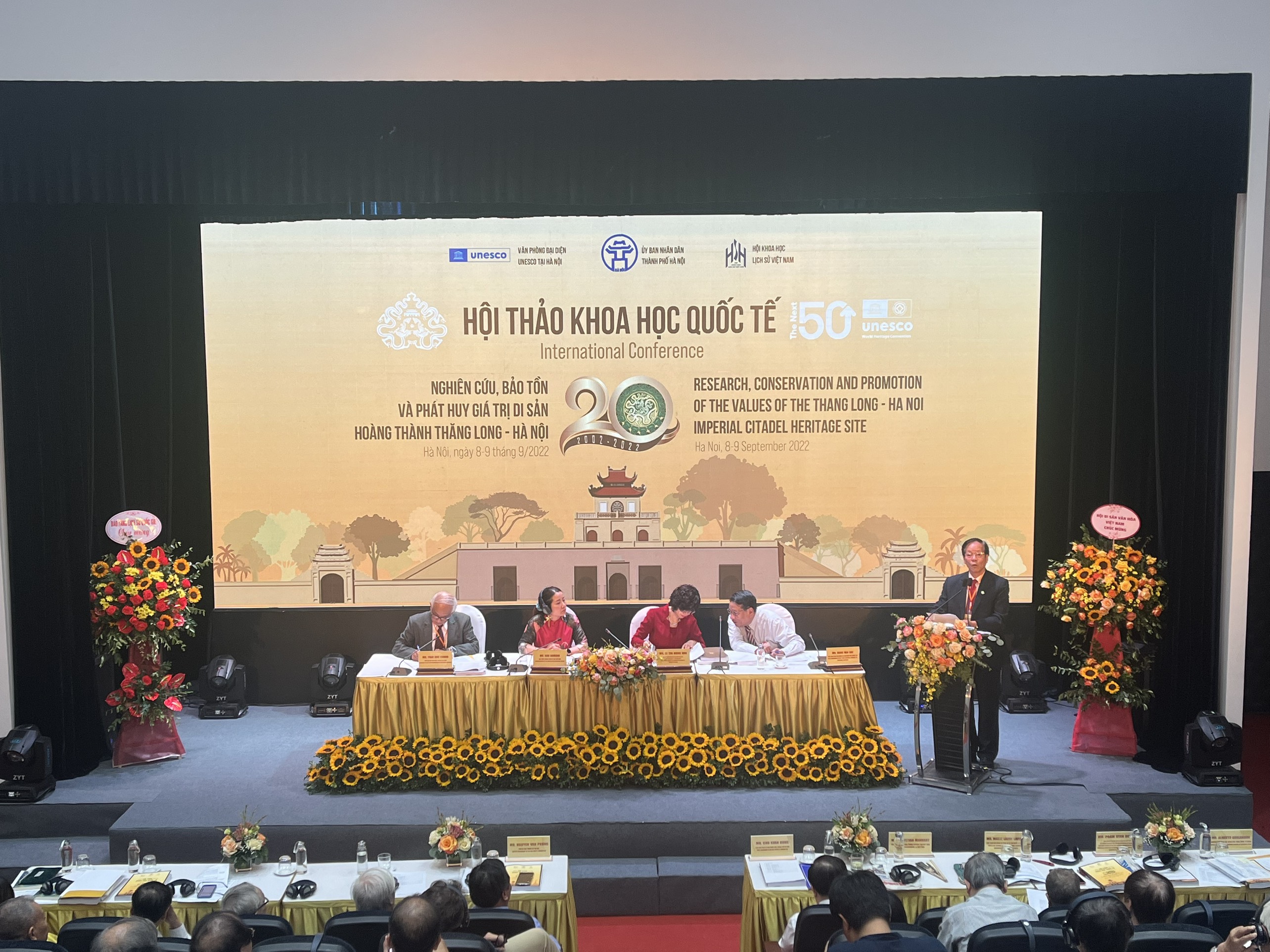
To continue to manage , preserve and promote the value of the World Cultural Heritage of Thang Long Imperial Citadel in order to continue to comply with 8 commitments with UNESCO . On behalf of the Hanoi City UNESCO Association, I propose a few ideas:
1. The heritage site has been associated with the National Center of Power for thousands of years, ie closely related to the activities of theCourt – Royal family through many dynasties. Therefore, it is necessary to continue collecting, researching and gradually restoring and recreating intangible cultural values...
2. Continue to implement the master plan on digital transformation to both document heritage and artifacts and contribute to bringing the values of the monument to the public faster and more effectively. In the immediate future, use information technology or virtual reality to support the interpretation and interpretation of the heritage and increase the attraction to the public and visitors.
3 - On the basis of the results of research into historical documents and archaeological excavations, the restoration of the main space of Kinh Thien Palace and Kinh Thien Palace should speed up implementation. In the immediate future, it is to restore in the form of drawings, 3D images, "virtual reality" space by digital technology as an open plan for exchange, discussion and criticism to reach consensus in the community. copper . It is the desire of the people of Hanoi that the main space of Kinh Thien Palace and Kinh Thien Palace will soon become existing works in the world heritage site of the Imperial Citadel of Thang Long.
Discussion session on the afternoon of September 9, 2022
Executive Presidium
Prof. Dr. Nguyen Quang Ngoc - Vice Chairman of the Vietnam Historical Science Association
Assoc. Prof. Dr. Dang Van Bai - Vice Chairman of the National Council of Cultural Heritage
Presentation by Mr. Alberto Garlandini – President of the International Museums Council ICOM (2020 – 2022)
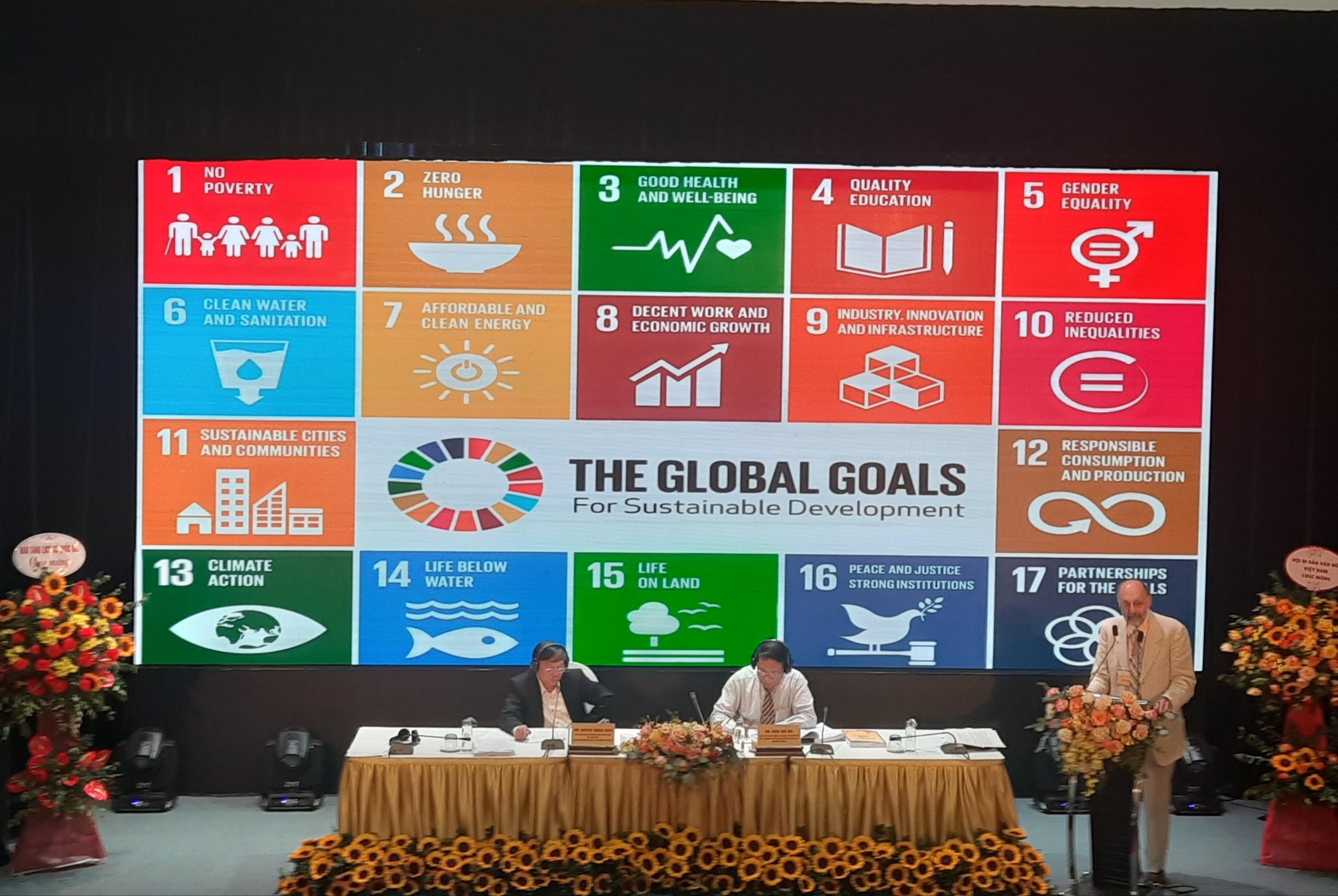
Museums and heritage live in the contemporary period and must address the essential issues of the times.
Global challenges require coordinated responses on a global scale. Heritage protection requires cooperation. International cooperation is needed now more than ever to protect museums and heritage sites during emergencies, conflicts and natural disasters.
The World Heritage site is currently facing the existential threat of climate change. It is imperative that we react before it is too late.
The contribution of museums is very important, regardless of their type, collection, size and location. The museum is one of the most trusted institutions. The museum is uniquely positioned to promote inclusion and diversity, support environmental policies and post-pandemic strategies, disseminate scientific information, and promote sustainable practices in local communities. direction. ICOM actively participates in international government forums and meetings to ensure that decision-makers worldwide recognize and integrate museums and cultural institutions into their policies. to address heritage, museums, sustainability and the climate crisis.
He concluded his talk by quoting a familiar motto, “Think Global, Act Local”. This motto was proposed in 1971 by David Brower, founder of Friends of the Earth. It is essential that the great challenges of our time be discussed in international conferences and summits. However, if we want to create a prosperous, nurturing, sustainable and peaceful world, we must act locally, in our daily lives. That is a real challenge for every museum and cultural institution, every specialist in the field of museums and heritage, and every citizen.
Presentation of GSTS. Truong Quoc Binh
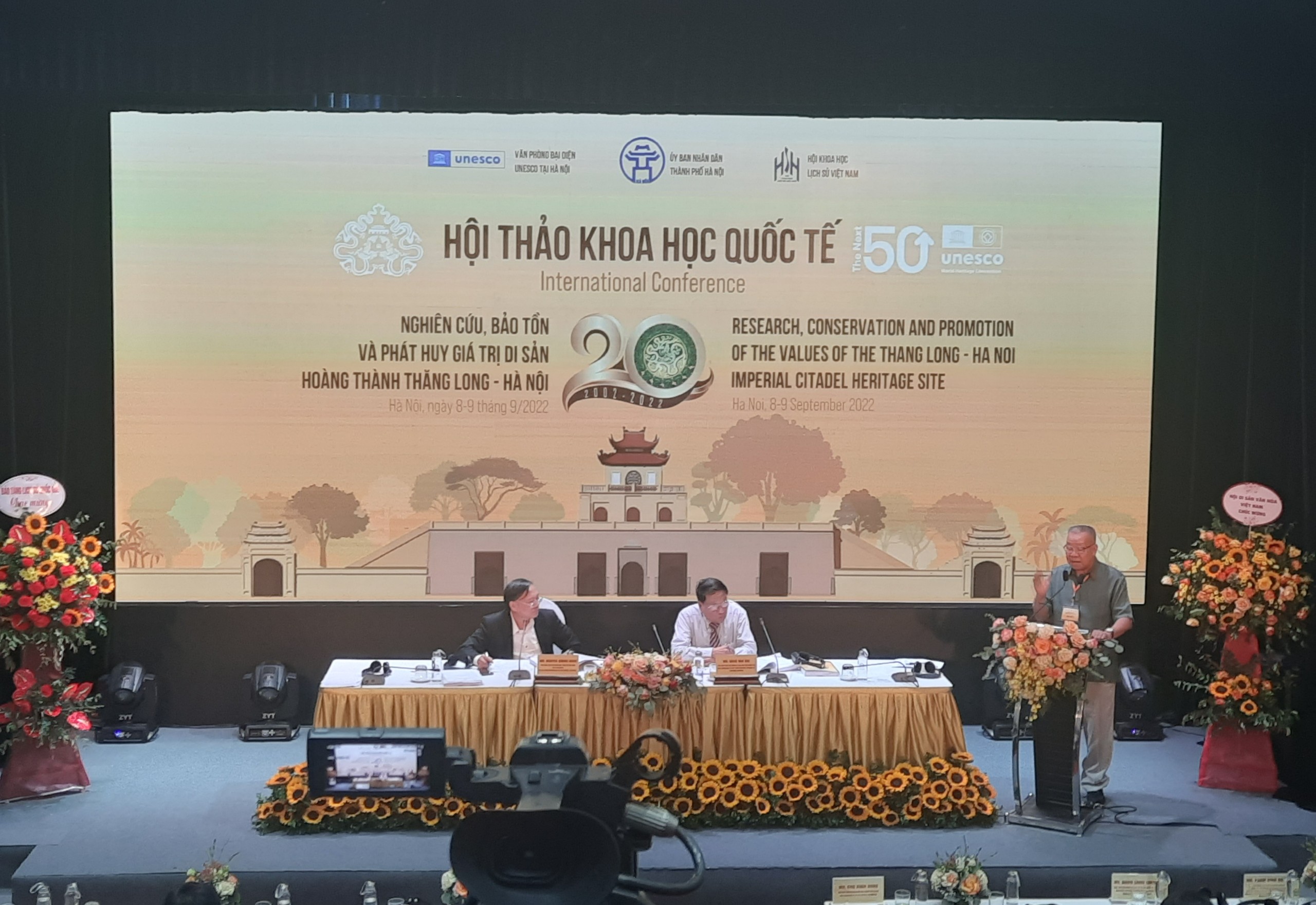
In protecting, preserving and promoting heritage values, he gave two opinions:
- Proposing handover of the exhibition house next to the National Assembly building to the Center for Conservation of Imperial Citadel of Thang Long - Hanoi.
- Honoring the person who is considered the first mayor of Thang Long - Mr. Luu Co, according to him, there should be a statue to worship Mr. Luu Co and name the street after him.
Presentation of Dr. TOMODA Masahiko – Tokyo National Cultural Heritage Research Institute
International cooperation in research and conservation of Thang Long Imperial Citadel
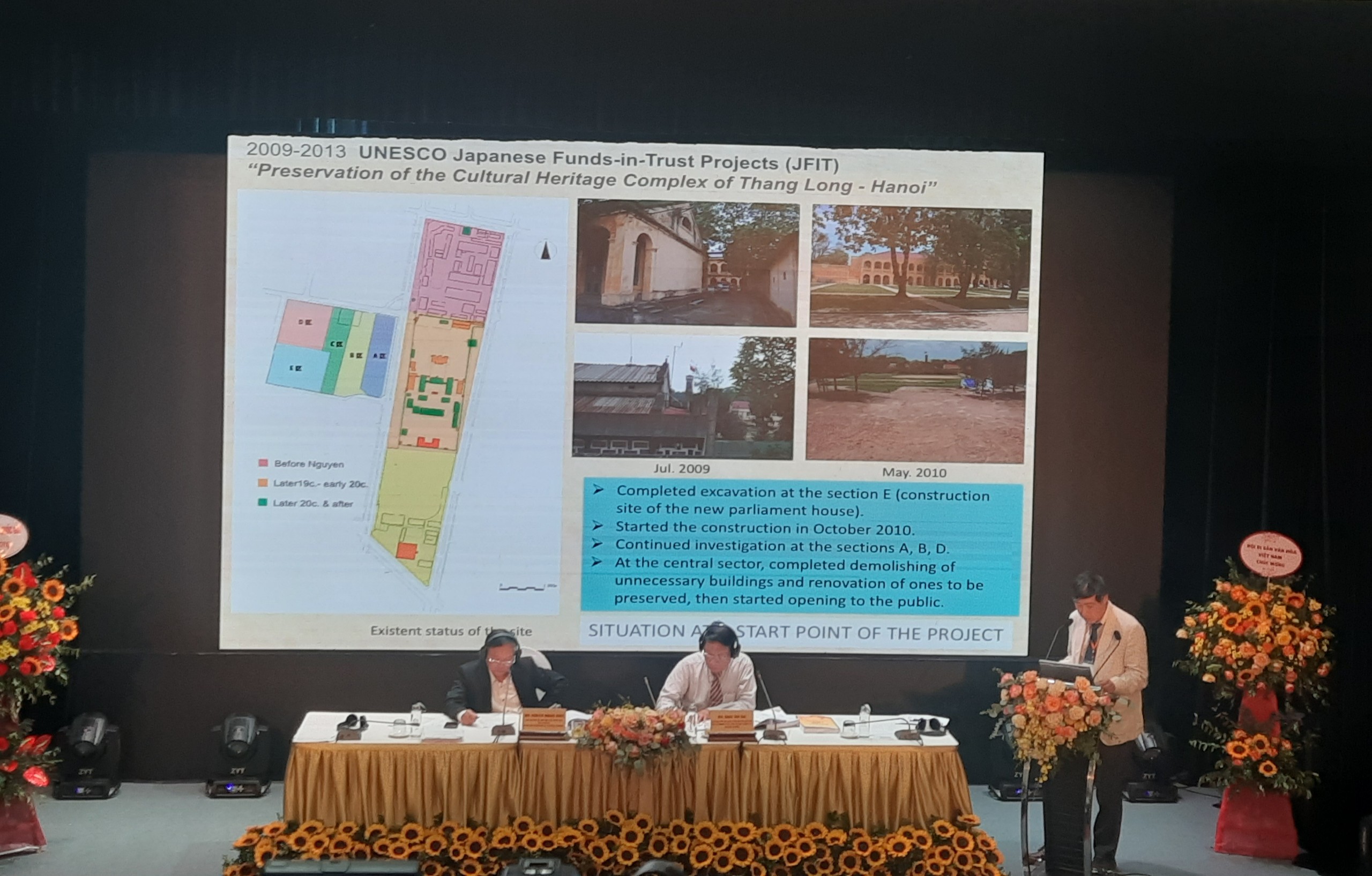
He affirmed the achievements of 20 years of research in conservation and promotion of heritage, largely based on on international cooperation in this field. Cooperate in the initial research excavation and that process will continue into the future. This is also the training environment for human resources of the Imperial Citadel of Thang Long Heritage Conservation Center - Hanoi.
Mr. Assoc. Prof. Dr. Dang Van Bai
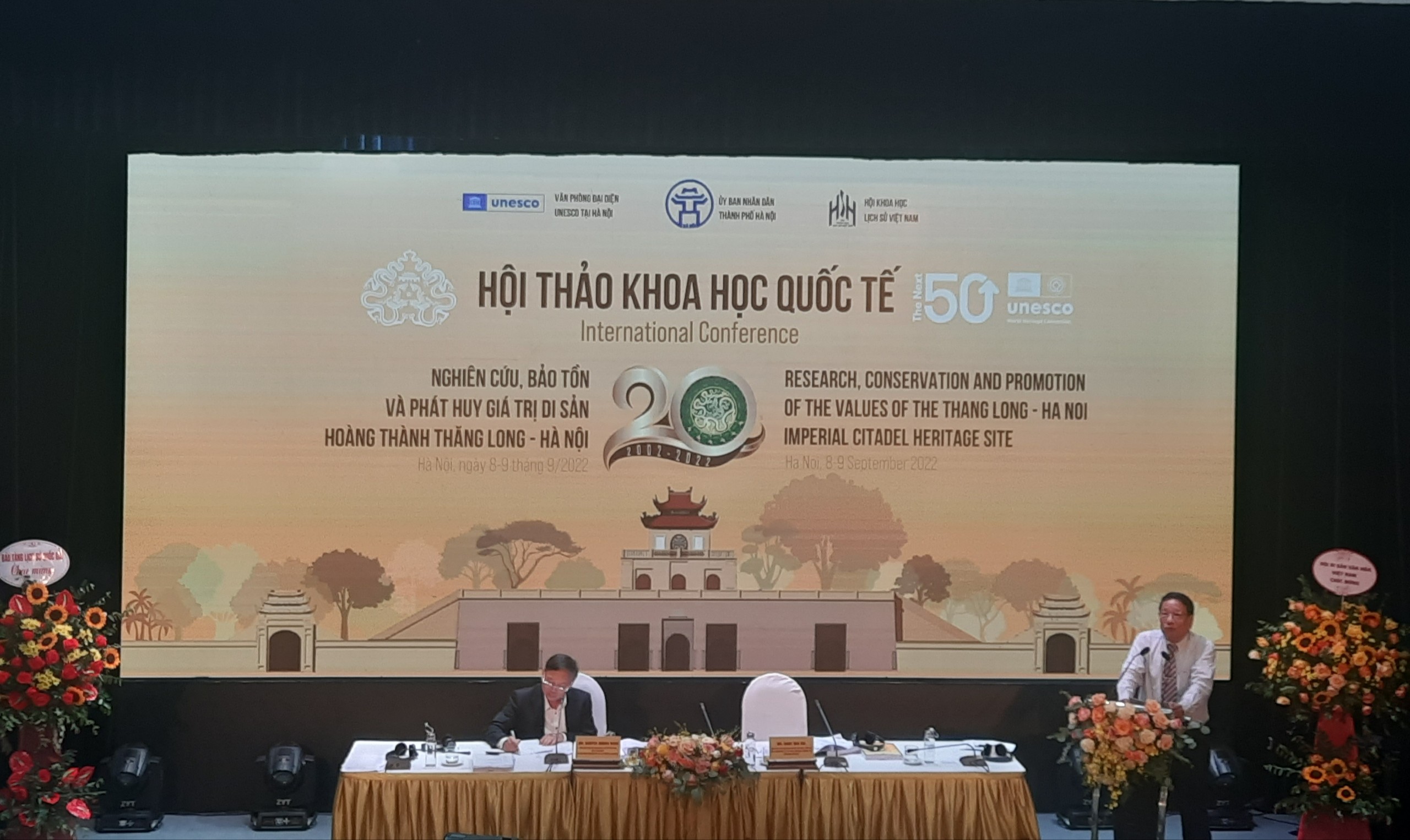
- According to him, we should approach the Heritage Area as a heritage city; restore and revive ancient rivers so that Thang Long Imperial Citadel will have a new vitality and have the opportunity to be honored by Unesco for the second time.
- Spiritual perspective: recognize Thang Long Imperial Citadel as a sacred, dark and sacred space.
Mr. Hoang Viet Trung Architect - Director of Hue Monuments Conservation Center
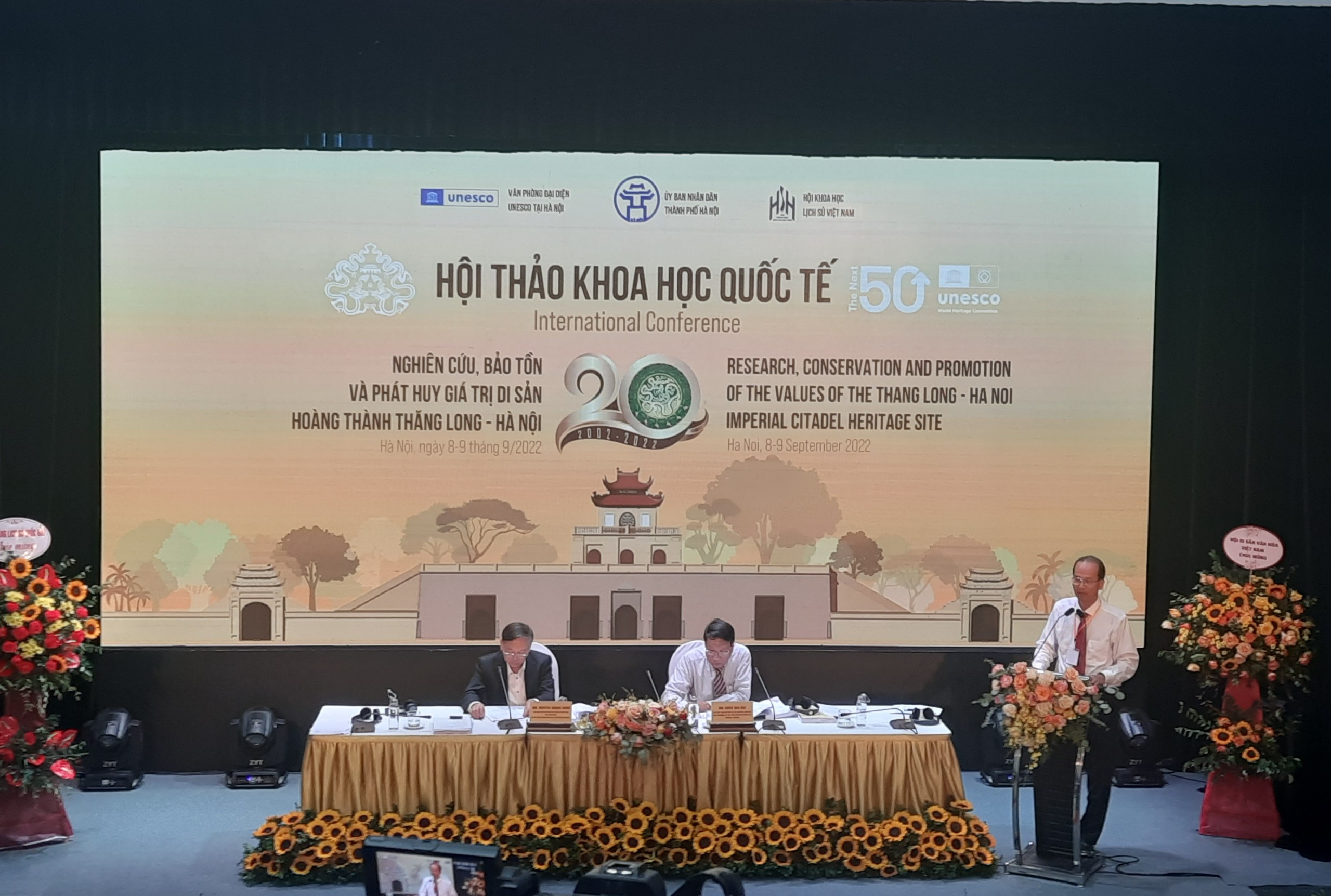
Sharing experiences in the restoration of Hue ancient capital
To restore, it is necessary to prepare materials, textures and patterns to put in. From carpenters, woodworkers, and mosaics are all unique, products that are almost unavailable on the market and cannot be purchased.
Mr. Assoc. Prof. Dr. Pham Mai Hung
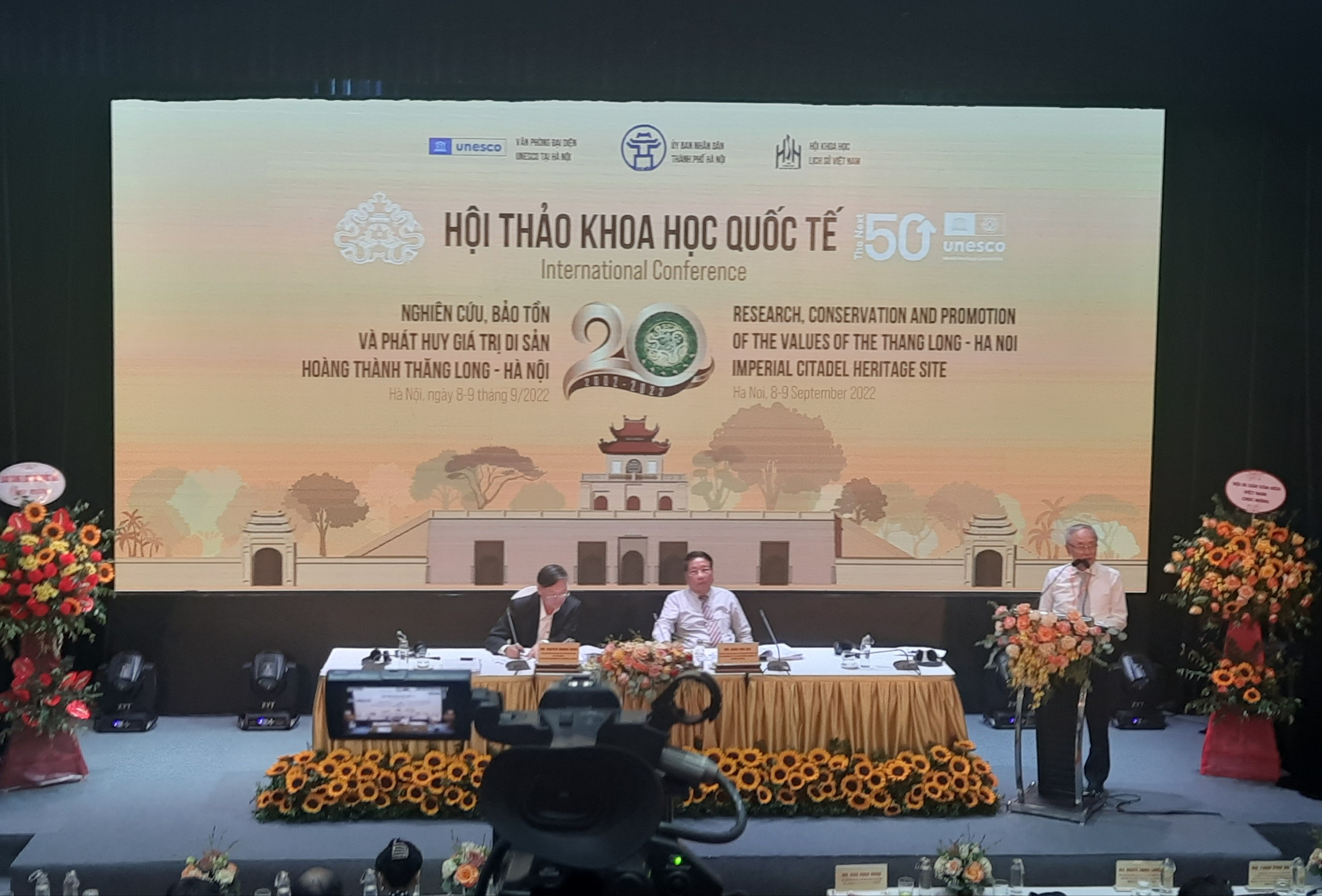
To further promote the research of the Imperial Citadel of Thang Long in a comprehensive manner with a basis for conservation and promotion of the heritage's values.
Dr. Liu Meiji
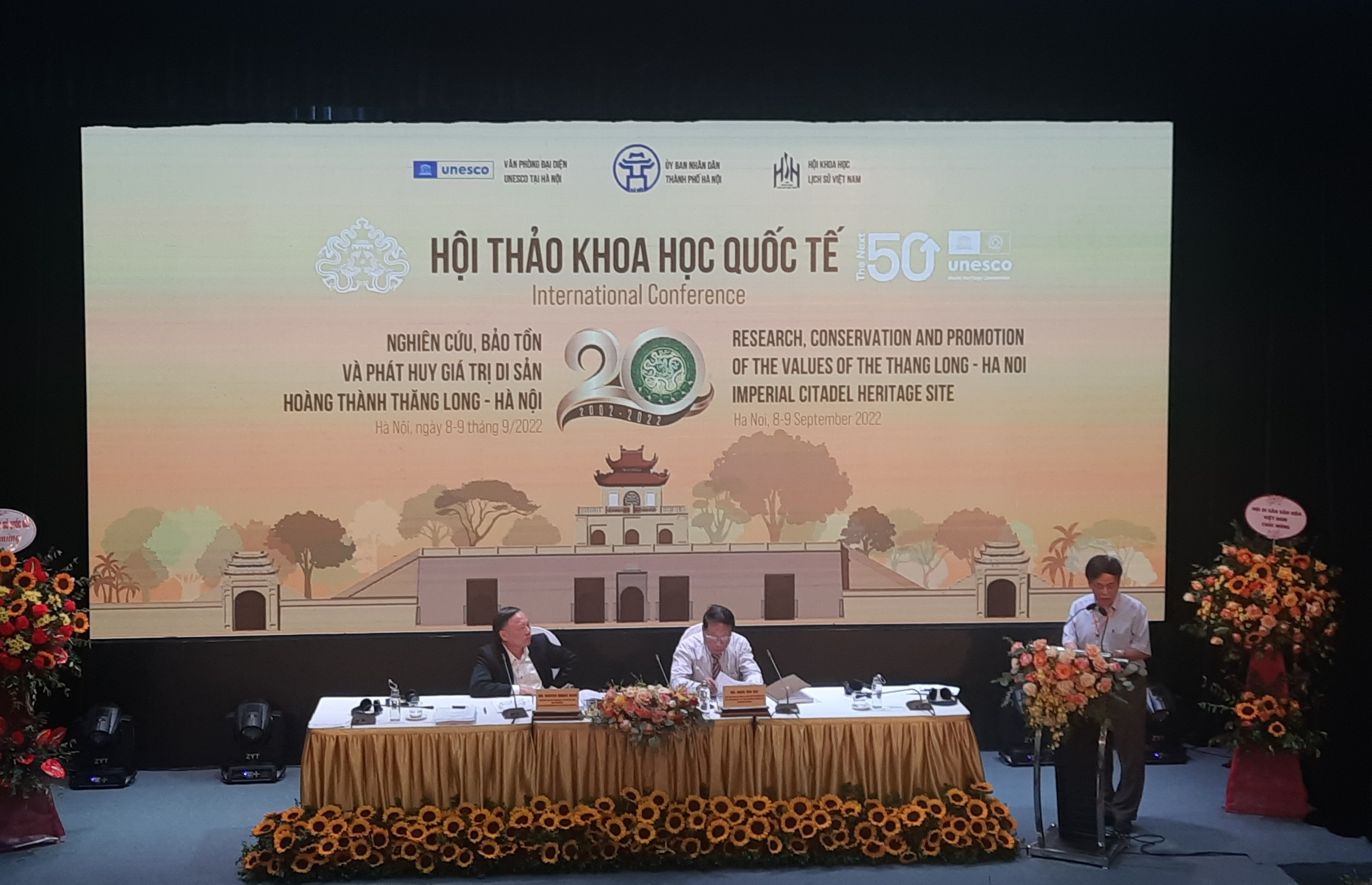
Urgently actively restore Kinh Thien Palace, the Management Board of the Heritage Area should go to Thanh Hoa to study the Kinh Tomb area, establish a research committee to restore Kinh Thien Palace in Hanoi, within 5 years - 10 years to have Kinh Thien Palace in Hanoi.
Dr. Le Thi Minh Ly – Vietnam Cultural Heritage Association
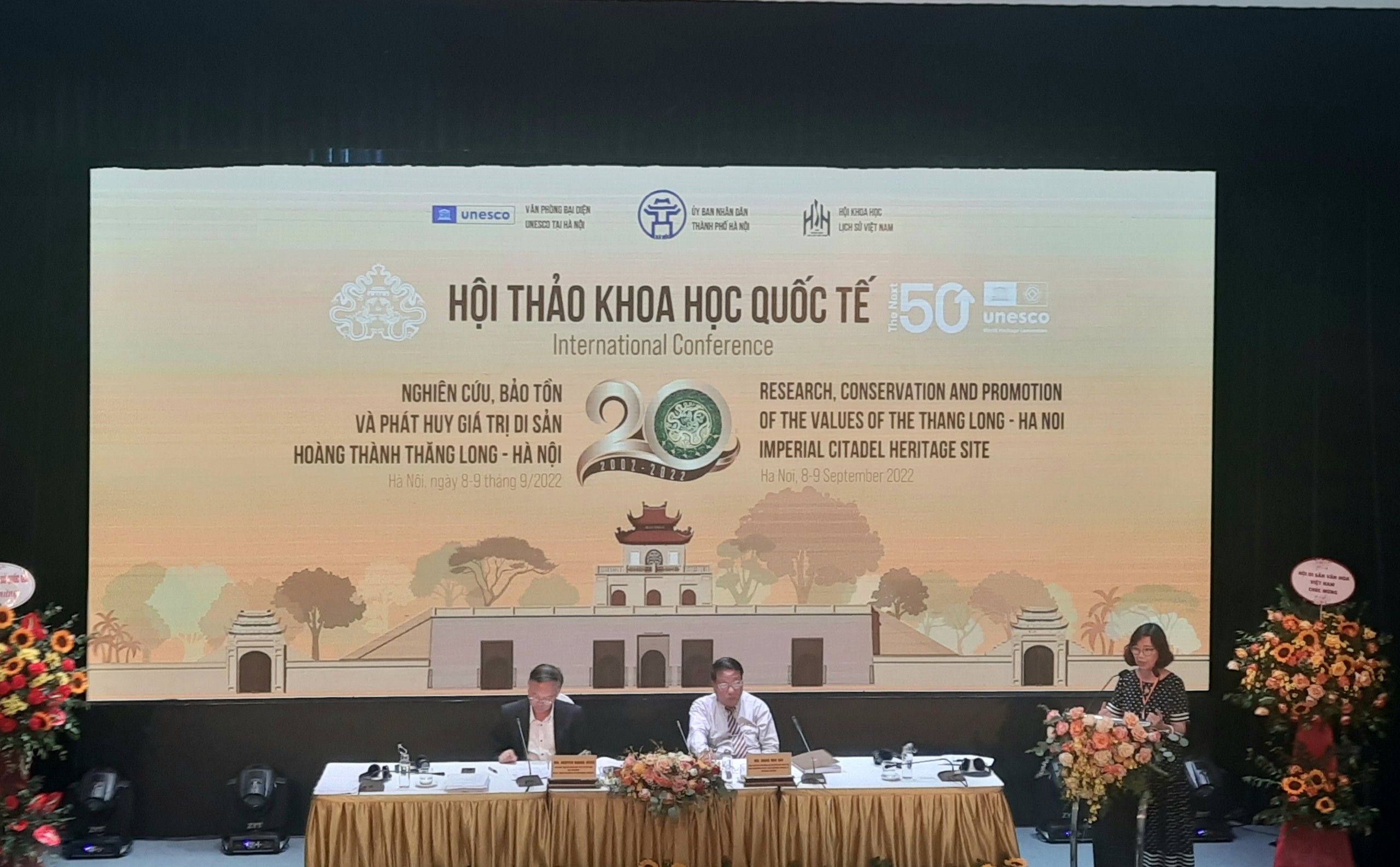
- Intangible cultural heritage protection is late but the development speed is very fast.
Imperial Citadel of Thang Long needs to promote more intangible elements, creating a regular custom. Further research on intangible cultural heritage is needed. What is the intangible cultural heritage of the Imperial Citadel?
- Promoting heritage education
- Training and improving management capacity
At the end of the workshop on September 9, 2022, the Organizing Committee issued a statement, which is the basis for the conservation and sustainable promotion of the heritage value of the Imperial Citadel of Thang Long - Hanoi.
Mr. Chu Xuan Dung - Vice Chairman of Hanoi People's Committee delivered the closing speech of the workshop and thanked and wished good health to the delegates, experts and scientists.
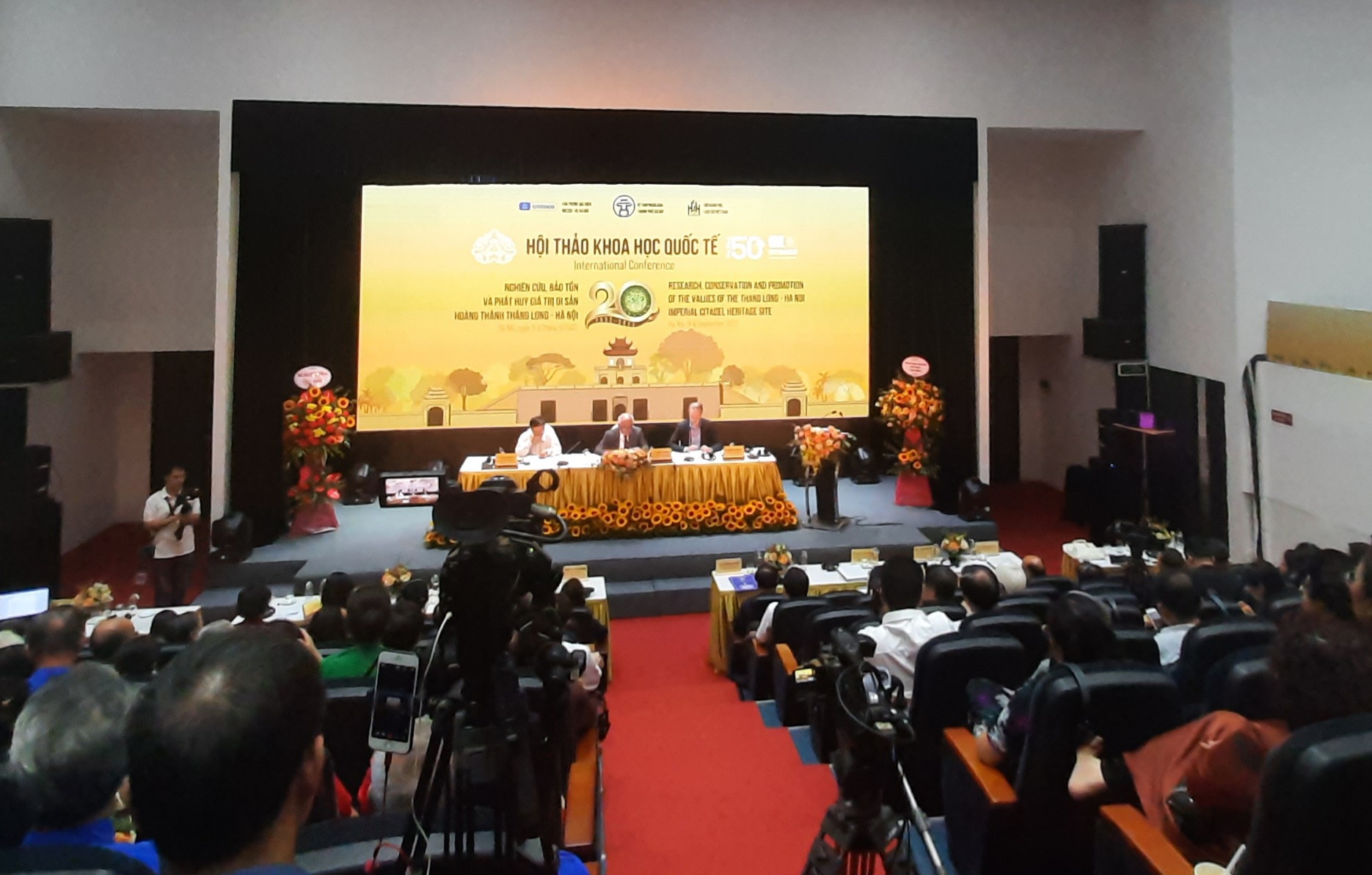
The international scientific conference: "20 years of researching, preserving and promoting the value of the Imperial Citadel of Thang Long - Hanoi" has been a great success. The organizers sincerely thank the press and media agencies for reporting on the conference. We look forward to your companionship in the process of preserving and promoting the World Heritage values of the Imperial Citadel of Thang Long - Hanoi.
Press information:
Assoc. Prof. Dr. Tran Duc Cuong - President of Vietnam Historical Science Association - Vice Chairman of Scientific Advisory Council for Research on Co Loa relic site - Hanoi Citadel;
Ms. Nao Hayashi - Asia-Pacific Culture Specialist, World Heritage Center
Ambassador Le Thi Hong Van - Chief Representative of the Vietnamese Delegation to UNESCO (in Paris, France)
Assoc. Prof. Dr. Dang Van Bai - Vice Chairman of the National Council of Cultural Heritage

Speech by Mr. Emmanuel CERISE - Director of PRX Vietnam (representative of the Ile de France region) in Hanoi
Suggestions for the model and planning of exhibition space archeology and architecture for Imperial Citadel of Thang Long and Hanoi, opportunities for cooperation between Hanoi and the Ile de france region

Urban archeology is currently facing many difficulties and obstacles in preserving and promoting its values. Urban heritage is easily destroyed, the conservation and promotion work encounters many obstacles and limitations due to urban development, infrastructure development such as traffic, restaurants, shops, etc. The panel discussion is about archaeological sites as a potential for urban design projects integrated in contemporary urban development. We will present models from the Ile de France Region (IDF) and Europe, and point out some opportunities for cooperation between Hanoi and the Ile de France Region.
1. Models
The Saint - Denis Archaeological Site (Ile de France) is a model of the archaeological site integrated in the urban renovation project, using landscape and urban design to preserve heritage and represent historical vestiges. history in the past.
The Heritage Sites of Saint Laurent and the Pastoral College in Aosta (Italy) are an example of the permanent management of an urban archaeological site for historical, cultural and touristic purposes.
2. Cooperation between Hanoi and Ile de France
Some of the archaeological sites in the Ile de France Region are located in urban areas, for example the city of Lutèce (Roman times) or Cluny (medieval times), some are located in the suburbs or in the countryside. villages such as the Gallo-Roan Heritage Site of the Vaux de la Celle (Genainville).
The Ile de France region, together with PRX-Vietnam, can assist in connecting the historical sites of Hanoi and the heritage sites in the Ile de France region; building cooperation, exchange and technical assistance, such as the cooperation between the medieval town of Provins and the Citadel of Hanoi, the support of the French Ministry of Culture in the field of training and fostering for staff French-speaking working at historic sites.
Collaboration opportunities can be:
- Collaboration on a specific project, for example a project to design a contemporary city to preserve and promote heritage;
- Technical support in the field of communication and promotion;
- Support to build a network of heritage sites (in Hanoi and between the heritage sites of Hanoi and the Ile de France);
- Introduce highly specialized architects, urban designers and landscape designers to work in archaeological and historical sites.
Lecture of GS. Kunikazu Une - Professor Emeritus of Nara Women's University
Experience in restoring architecture from archaeological sites.

Structures in Japan were built of wood, so they were mostly destroyed over time. Very few ancient structures have survived to this day and all are Buddhist structures. During the excavation process, we have discovered many relics and vestiges of ancient works.
In Japan, we have a lot of experience in rebuilding destroyed buildings with only traces left behind. In my presentation, I will briefly introduce some of the reconstructed structures in Japan such as Suzaku-mon (main gate), Daigoku-den (main hall) and Tou-in (east garden). in “Heijou-kyu”: Nara Palace Site). These buildings were built in the middle of the 8th century. And I also introduce another building built in the middle of the 9th century which is the main south gate at “Shiwa-jo”.
How do we get an idea of what those ancient structures will look like? First, we can rely on the results of archeology. After that, we restored the destroyed structures based on the research results. We can build sketches (I think it's like 70% - 80% of ancient architecture, however we will have the problem that there are some details that can't be determined exactly, sometimes there are ideas. differing opinions on the underlying idea).
Studying the ancient structures that still exist today in Japan, fortunately we still have about 60 ancient structures. This is a resource that provides a lot of information about the age and structure of ancient architecture.
During research, we often have to build models at scale 1/50 to 1/100. We check for various issues during the restoration process. When welcoming the public to visit the reconstruction, we must pay attention to at least two issues: safety and preservation of the original artifacts.
Safety: After the reconstruction is completed, everyone will visit the building. We need to establish safety in reconstructed buildings.
Preservation of archaeological relics: The work is restored on the principle of never destroying artifacts of original value.
Presentation by Assoc. Prof. Dr. Le Thi Thu Hien - Director of Cultural Heritage Department, Ministry of Culture, Sports and Tourism (Presentation: Mr. Tran Dinh Thanh - Deputy Director)
Orientation for management of world cultural heritages Imperial Citadel of Thang Long - Hanoi according to the point of view of sustainable development of Unesco

Vietnam currently has 8 World Cultural and Natural Heritages, of which Imperial City Center Thang Long - Hanoi citadel was recognized by UNESCO in 2010, marking a big step forward in the research process of this particularly important heritage site.
On the basis of 06 contents of World Heritage management identified under the Convention, the Guidelines for the implementation of the 1972 Convention and Vietnam's practice, the discussion clarifies the management status of the Central Citadel of Thang Long. Long - Hanoi after 20 years of research and conservation, through the understanding of the process:
1. Building the management apparatus and human resources of the Imperial Citadel of Thang Long - Hanoi.
2. Formulating and promulgating legal documents on World Heritage management.
3. Develop a plan for management, planning and investment of financial resources.
4. Scientific and technical research activities.
5. International cooperation.
6. World Heritage Monitoring.
At the same time, on the basis of an overall assessment when compared with the management status of other World Cultural and Natural Heritage sites in Vietnam, to propose solutions to improve the efficiency of heritage management, including: The whole solution needs to strengthen the integration of activities to protect and promote the World Heritage values of the Central Imperial Citadel of Thang Long - Hanoi with the sustainable development perspective of UNESCO in the coming time.
Presentation of Ms. Nao Hayashi – Asia-Pacific cultural expert, World Heritage Center
Preserving outstanding global values of World

Heritage Sites The World Heritage Convention was established in 1972 by the Countries around the world are increasingly aware that the responsibility for preserving some natural or cultural heritage sites of universal value belongs not only to individual countries but also to the entire international community.
Up to now, 1154 heritages have been inscribed on the World Heritage List. The Convention has a total of 194 member states including 27 countries that have not yet registered any heritage.
A site, once inscribed on the World Heritage List, becomes a member of the global community of this Convention. The World Heritage Convention is one of the most widely followed legal instruments.
In addition to the main text of the Convention, which presents the legal provisions of the World Heritage regime and its most important rules, the operational guidelines (most recently revised for 2021) also provide technical and detailed guidance to assist in the implementation of the convention.
For example, the Guidelines include procedures for developing a tentative list of nominees, a process for preparing nominations, and importantly, guidance on various aspects of the management, conservation, and monitoring of these resources. The property is a World Heritage Site.
In 2022, its 50th anniversary, the Convention is facing many challenges arising from changes in lifestyles, in conceptions of heritage and its significance in the general context of the agenda. Sustainable Development.
Preserving Outstanding Universal Values requires constant reflection, contemplation and innovation to bring harmony between the needs of modern life, heritage values and people's aspirations for a future. better.
Comment of Mr. Jean Francois Milou – French expert, Studio Milou Singapore office
Researching architectural design solutions to preserve and promote the value of archaeological site 18 Hoang Dieu

Experts and scientists at home and abroad participated in the discussion of
GSTS Architects Nguyen Quoc Thong's

speeches on restoration of electricity and space of Kinh Thien Palace: He thinks this is an opportunity, up to this point it is an opportunity. what we have to do, we have certain scientific bases, the most basic that can be asserted, the structure or position of the highest center of power has been determined.
In the course of further research, a multidisciplinary collaboration is needed, including architects specializing in conservation, heritage, architecture and urbanism.
Mr. Tomoda Masahiko

He said that there should be general principles before carrying out conservation and promotion of heritage values.
He emphasized the problem: care should be taken between the display and preservation of discovered archaeological artifacts.
Mr. Truong Minh Tien - President of Hanoi UNESCO Association

To continue to manage , preserve and promote the value of the World Cultural Heritage of Thang Long Imperial Citadel in order to continue to comply with 8 commitments with UNESCO . On behalf of the Hanoi City UNESCO Association, I propose a few ideas:
1. The heritage site has been associated with the National Center of Power for thousands of years, ie closely related to the activities of theCourt – Royal family through many dynasties. Therefore, it is necessary to continue collecting, researching and gradually restoring and recreating intangible cultural values...
2. Continue to implement the master plan on digital transformation to both document heritage and artifacts and contribute to bringing the values of the monument to the public faster and more effectively. In the immediate future, use information technology or virtual reality to support the interpretation and interpretation of the heritage and increase the attraction to the public and visitors.
3 - On the basis of the results of research into historical documents and archaeological excavations, the restoration of the main space of Kinh Thien Palace and Kinh Thien Palace should speed up implementation. In the immediate future, it is to restore in the form of drawings, 3D images, "virtual reality" space by digital technology as an open plan for exchange, discussion and criticism to reach consensus in the community. copper . It is the desire of the people of Hanoi that the main space of Kinh Thien Palace and Kinh Thien Palace will soon become existing works in the world heritage site of the Imperial Citadel of Thang Long.
Discussion session on the afternoon of September 9, 2022
Executive Presidium
Prof. Dr. Nguyen Quang Ngoc - Vice Chairman of the Vietnam Historical Science Association
Assoc. Prof. Dr. Dang Van Bai - Vice Chairman of the National Council of Cultural Heritage
Presentation by Mr. Alberto Garlandini – President of the International Museums Council ICOM (2020 – 2022)

Museums and heritage live in the contemporary period and must address the essential issues of the times.
Global challenges require coordinated responses on a global scale. Heritage protection requires cooperation. International cooperation is needed now more than ever to protect museums and heritage sites during emergencies, conflicts and natural disasters.
The World Heritage site is currently facing the existential threat of climate change. It is imperative that we react before it is too late.
The contribution of museums is very important, regardless of their type, collection, size and location. The museum is one of the most trusted institutions. The museum is uniquely positioned to promote inclusion and diversity, support environmental policies and post-pandemic strategies, disseminate scientific information, and promote sustainable practices in local communities. direction. ICOM actively participates in international government forums and meetings to ensure that decision-makers worldwide recognize and integrate museums and cultural institutions into their policies. to address heritage, museums, sustainability and the climate crisis.
He concluded his talk by quoting a familiar motto, “Think Global, Act Local”. This motto was proposed in 1971 by David Brower, founder of Friends of the Earth. It is essential that the great challenges of our time be discussed in international conferences and summits. However, if we want to create a prosperous, nurturing, sustainable and peaceful world, we must act locally, in our daily lives. That is a real challenge for every museum and cultural institution, every specialist in the field of museums and heritage, and every citizen.
Presentation of GSTS. Truong Quoc Binh

In protecting, preserving and promoting heritage values, he gave two opinions:
- Proposing handover of the exhibition house next to the National Assembly building to the Center for Conservation of Imperial Citadel of Thang Long - Hanoi.
- Honoring the person who is considered the first mayor of Thang Long - Mr. Luu Co, according to him, there should be a statue to worship Mr. Luu Co and name the street after him.
Presentation of Dr. TOMODA Masahiko – Tokyo National Cultural Heritage Research Institute
International cooperation in research and conservation of Thang Long Imperial Citadel

He affirmed the achievements of 20 years of research in conservation and promotion of heritage, largely based on on international cooperation in this field. Cooperate in the initial research excavation and that process will continue into the future. This is also the training environment for human resources of the Imperial Citadel of Thang Long Heritage Conservation Center - Hanoi.
Mr. Assoc. Prof. Dr. Dang Van Bai

- According to him, we should approach the Heritage Area as a heritage city; restore and revive ancient rivers so that Thang Long Imperial Citadel will have a new vitality and have the opportunity to be honored by Unesco for the second time.
- Spiritual perspective: recognize Thang Long Imperial Citadel as a sacred, dark and sacred space.
Mr. Hoang Viet Trung Architect - Director of Hue Monuments Conservation Center

Sharing experiences in the restoration of Hue ancient capital
To restore, it is necessary to prepare materials, textures and patterns to put in. From carpenters, woodworkers, and mosaics are all unique, products that are almost unavailable on the market and cannot be purchased.
Mr. Assoc. Prof. Dr. Pham Mai Hung

To further promote the research of the Imperial Citadel of Thang Long in a comprehensive manner with a basis for conservation and promotion of the heritage's values.
Dr. Liu Meiji

Urgently actively restore Kinh Thien Palace, the Management Board of the Heritage Area should go to Thanh Hoa to study the Kinh Tomb area, establish a research committee to restore Kinh Thien Palace in Hanoi, within 5 years - 10 years to have Kinh Thien Palace in Hanoi.
Dr. Le Thi Minh Ly – Vietnam Cultural Heritage Association

- Intangible cultural heritage protection is late but the development speed is very fast.
Imperial Citadel of Thang Long needs to promote more intangible elements, creating a regular custom. Further research on intangible cultural heritage is needed. What is the intangible cultural heritage of the Imperial Citadel?
- Promoting heritage education
- Training and improving management capacity
At the end of the workshop on September 9, 2022, the Organizing Committee issued a statement, which is the basis for the conservation and sustainable promotion of the heritage value of the Imperial Citadel of Thang Long - Hanoi.
Mr. Chu Xuan Dung - Vice Chairman of Hanoi People's Committee delivered the closing speech of the workshop and thanked and wished good health to the delegates, experts and scientists.

The international scientific conference: "20 years of researching, preserving and promoting the value of the Imperial Citadel of Thang Long - Hanoi" has been a great success. The organizers sincerely thank the press and media agencies for reporting on the conference. We look forward to your companionship in the process of preserving and promoting the World Heritage values of the Imperial Citadel of Thang Long - Hanoi.
Press information:
- https://tienphong.vn/ky-vong-dung-dien-king-thien-trong-10-nam-toi-post1468113.tpo
- https://www.vietnamplus.vn/truong-dai-dien-unesco-can-co-chien-luoc-va-ke-hoach-bao-ton-di-san/815334.vnp
- https://www.vietnamplus.vn/nhieu-chuyen-gia-quoc-te-du-hoi-thao-ve-hoang-thanh-thang-long/813964.vnp
- https://laodongthudo.vn/khai-mac-hoi-thao-quoc-te-ve-bao-ton-va-phat-huy-gia-tri-di-san-hoang-thanh-thang-long-ha- say-145743.html
- http://www.hanoimoi.com.vn/tin-tuc/Van-hoa/1041650/quan-ly-ben-vung-khu-di-san-hoang-thanh-thang-long
- https://hanoimoi.com.vn/tin-tuc/Van-hoa/1041520/hoang-thanh-thang-long---noi-hoi-tu-cac-gia-tri-lich-su-van-hoa- dan-toc
- http://daidoanket.vn/nang-tam-di-san-hoang-thanh-thang-long-5696210.html
- https://baotintuc.vn/van-hoa/ha-noi-phuc-dung-cac-di-san-kien-truc-cung-dien-tai-hoang-thanh-thang-long-20220910081735454.htm
- https://dangcongsan.vn/tu-tuong-van-hoa/hien-ke-khoi-phuc-cac-di-san-kien-truc-hoang-thanh-thang-long-619195.html
- https://dangcongsan.vn/tu-tuong-van-hoa/20-nam-nghien-cuu-bao-ton-va-phat-huy-gia-tri-di-san-hoang-thanh-thang-long- ha-noi-619071.html
- https://dangcongsan.vn/tu-tuong-van-hoa/trung-bay-bau-vat-hoang-cung-thang-long-619121.html
- https://cand.com.vn/Tieu-diem-van-hoa/huong-tiep-can-moi-trong-bao-ton-phat-huy-di-san-hoang-thanh-thang-long-i666956/
- https://cand.com.vn/Tieu-diem-van-hoa/phat-huy-gia-tri-van-hoa-truyen-thong-qua-tet-trung-thu-xu-huong-can-duoc- recommend-i666960/
- https://www.qdnd.vn/van-hoa/doi-song/bao-ton-va-phat-huy-gia-tri-di-san-hoang-thanh-thang-long-705041
- https://m.anninhthudo.vn/hien-thuc-hoa-giac-mo-phuc-dung-dien-king-thien-post516502.antd
- https://m.anninhthudo.vn/xay-dung-chien-luoc-bao-ton-di-san-hoang-thanh-thang-long-post516499.antd
Top








